Planex Communications CQW-MR200 Wireless LAN Mobile Router User Manual 2
Planex Communications inc. Wireless LAN Mobile Router 2
Contents
- 1. user manual 1
- 2. user manual 2
user manual 2
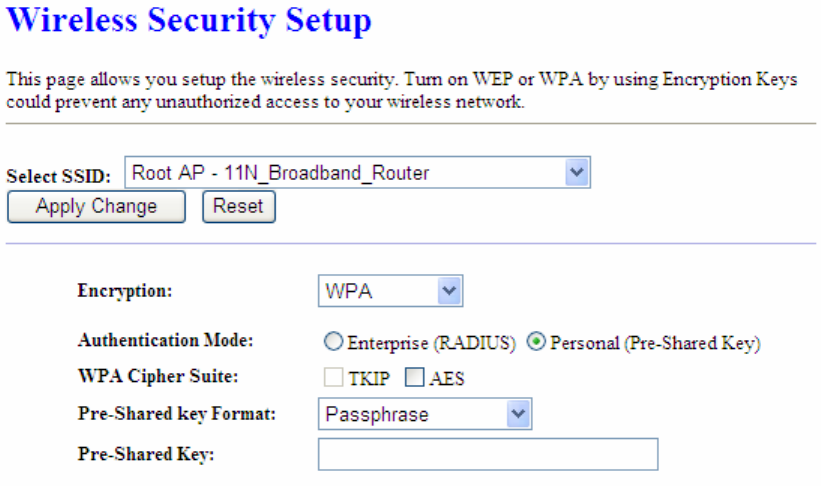
Version 1.0.15
101
3. Apply Changes & Reset
Click on Apply Changes to save the setting data. Or you may click on Reset to clear all the
input data.
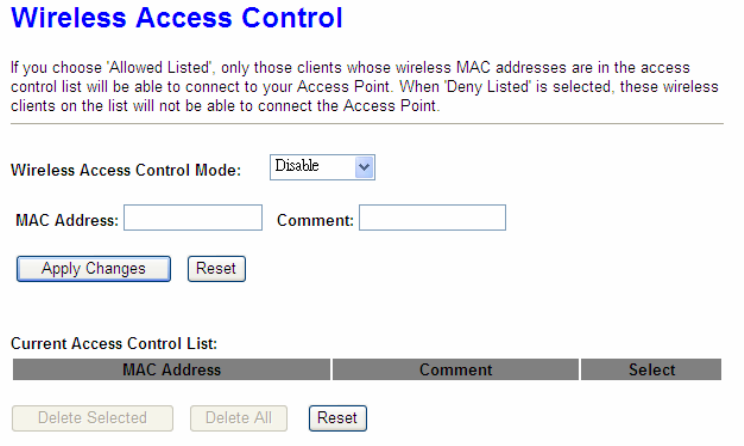
Version 1.0.15
102
6.2.4 Wireless Access Control
With the MAC address, you may allow or disallow the access to your AP.
1. Wireless Access Control Mode
“Allowed Listed” means only the MAC address listed on the allowed list can access to your
wireless network.
“Deny Listed” means the listed MAC Address are not allowed to link to your wireless
network.
“Disable” for function disuse.
2. MAC Address
Please input the allowed or denied MAC address, for example, 001122334455.
3. Comment
You may input the comments for the set MAC Address.
4. Apply Changes & Reset
Click on “Apply Change” to save the setting data. Or you may click on “Reset” to clear all the
input data.
5. Current Access Control List
In this list, all the MAC info you input will be displayed.
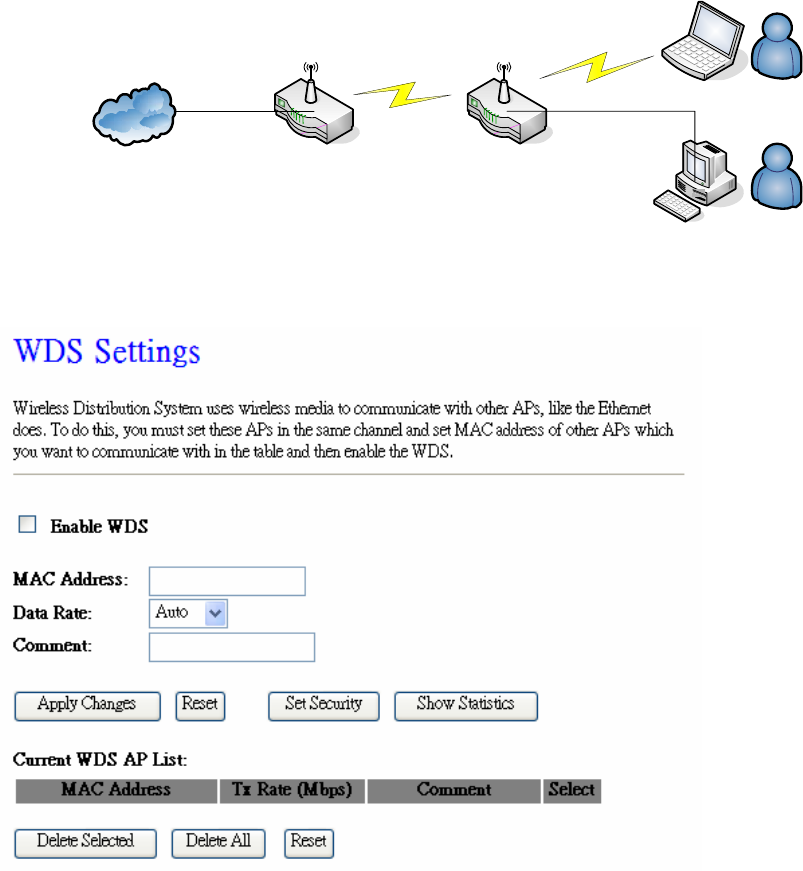
Version 1.0.15
103
6. Delete Selected and Delete All
Click on “Delete Selected” to erase the selected MAC address. Click on “Delete All” to erase
all the entered MAC Address.
6.2.5 WDS Settings
WDS (Wireless Distribution System) is a Wireless Access Point mode that enables wireless
bridging in which only WDS APs communicate with each other (without allowing for wireless
clients or stations to access them), and/or wireless repeating in which APs communicate both
with each other and with wireless stations (at the expense of half the throughput).
Internet
AP Router
WDS
AP Router
WDS
Wireless Connection
Wired Connection
Please follow the instructions to setup WDS connections.
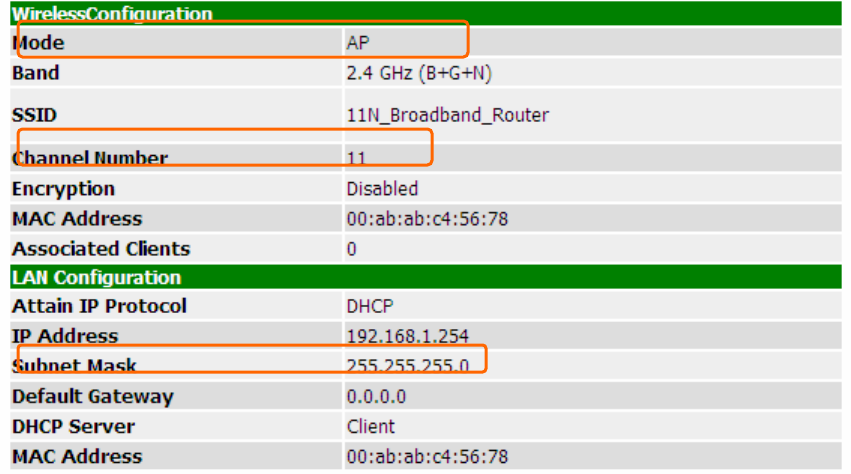
Version 1.0.15
104
Step 1. Check the MAC address and Channel number of the device you want to setup
WDS with 11N Mini Broadband Router .
Step 2. Get back to the menu “Wireless Basic Settings” of 11N Mini Broadband Router .
Select AP+WDS mode, and then select the Channel Number. Click Apply Changes to
save the setting data.
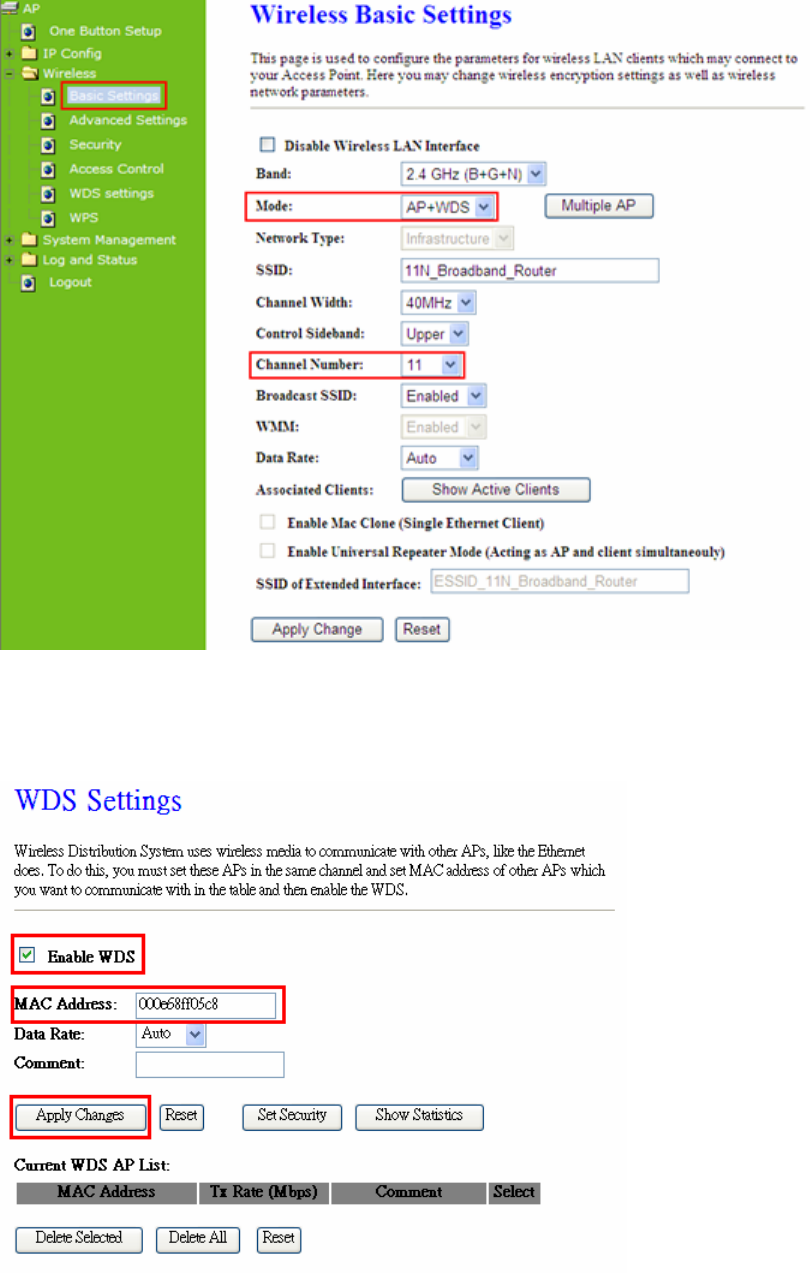
Version 1.0.15
105
Step 3. Enter the WDS Settings page, select Enable WDS, and then input the MAC
address of the paired device. Click Apply Changes to save the setting data.
Step 4. When the time counts down to 0, you will see the MAC address of the paired
device displaying on Current WDS AP List.
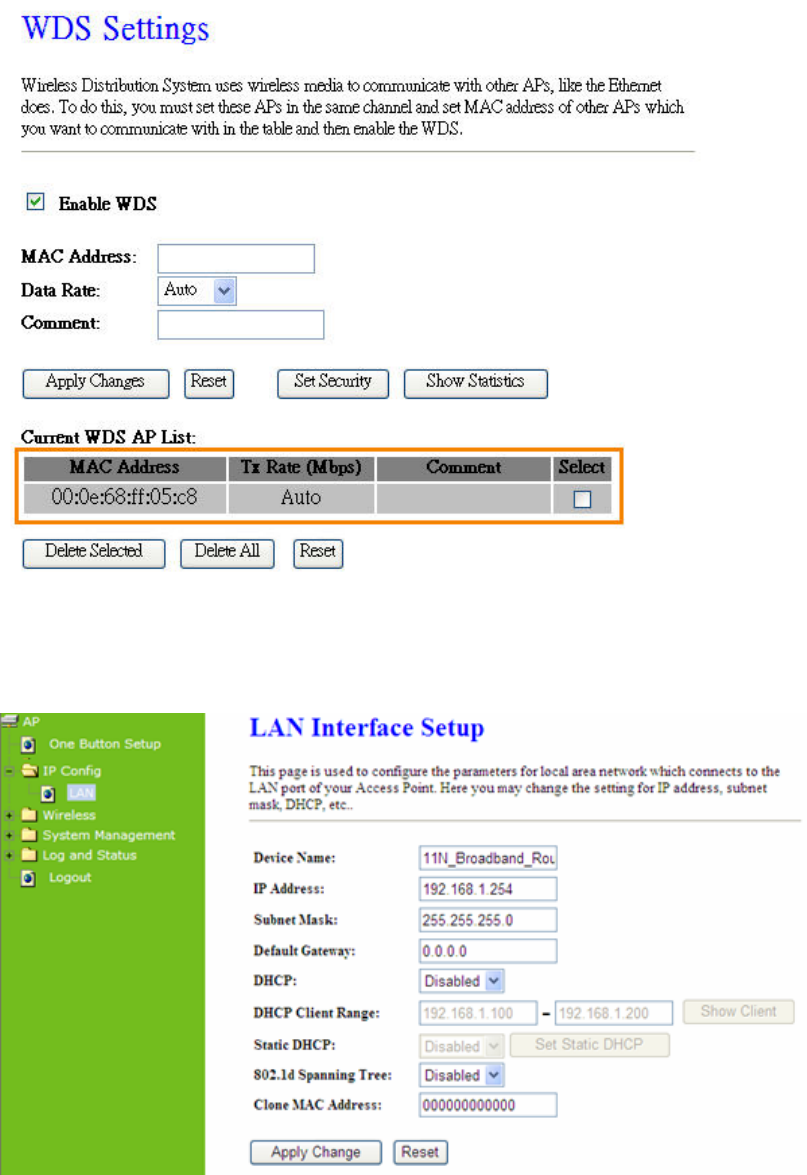
Version 1.0.15
106
Step 5. Head back to LAN Interface, disable DHCP option, and then click Apply
Changes to save the setting data.
Step 6. Doing the same way to setup the MAC address in the paired device. Launch the
UT to the menu “WDS settings” of the paired device, and input router’s MAC address. Click
Apply Changes to save the setting data.
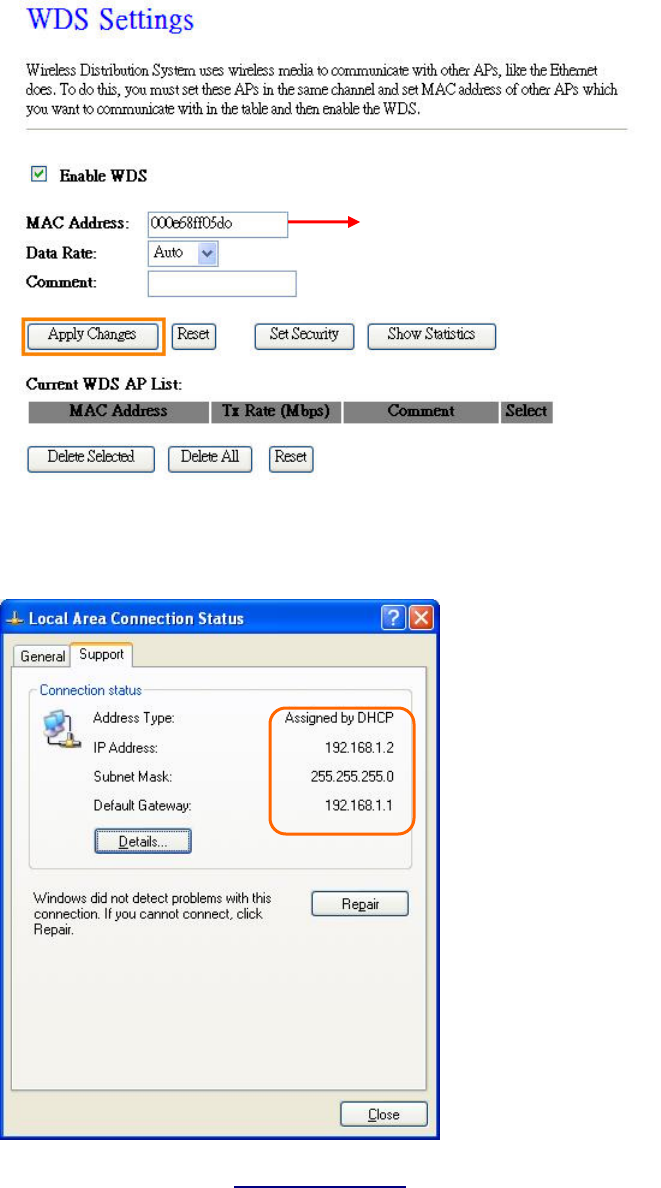
Version 1.0.15
107
Step 7. After initiating the paired device, please check Local Area Connections. Click
Supports to check out the IP address which is assigned by the paired device.
Step 8. You can input http://192.168.9.9 in IE browser to enter the GUI page of the paired
device and make sure the connection.
Input the MAC address here.
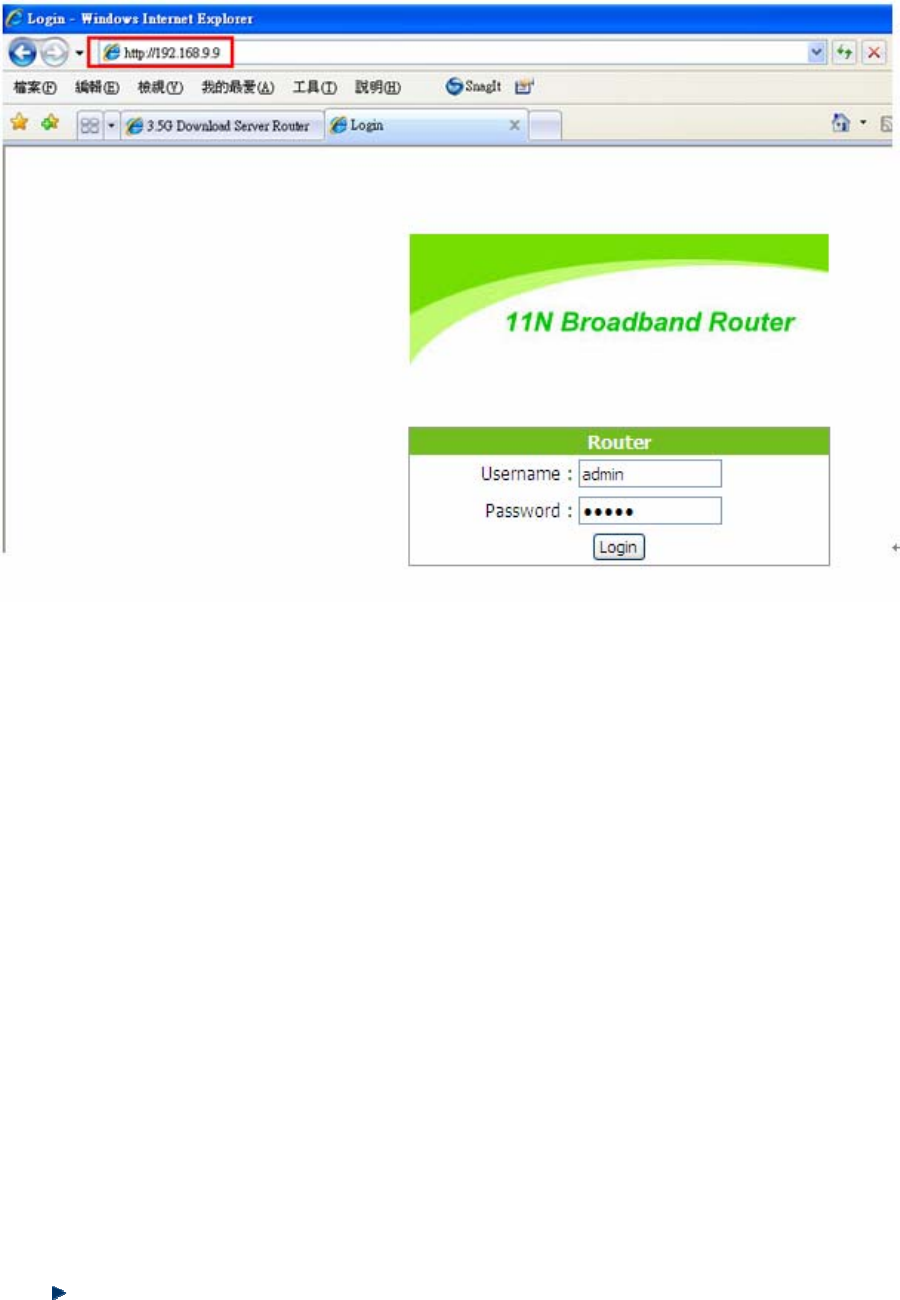
Version 1.0.15
108
6.2.6 WPS
Wi-Fi Protected Setup (WPS) is an easy way to establish a secured wireless network
between 11N Mini Broadband Router and wireless card. Users do not need to manually
entering a creative, yet predictable security key on both Wi-Fi devices to prevent unwanted
access to their wireless network. With WPS, it can automatically configure a wireless network
with a network name (SSID) and strong WPA data encryption and authentication.
WPS can be enabled by 2 methods:
1. PBC (Push button configuration) Method, in which the user simply has to push a
button, either an actual or a virtual one, on both WPS devices to connect.
2. PIN (Personal Identification Number) Method, in which a PIN has to be taken either
from a sticker label or from the web interface of the WPS device. This PIN will then be
entered in the AP or client WPS device to connect.
Please follow instructions below to enable the WPS function.
Start PBC:
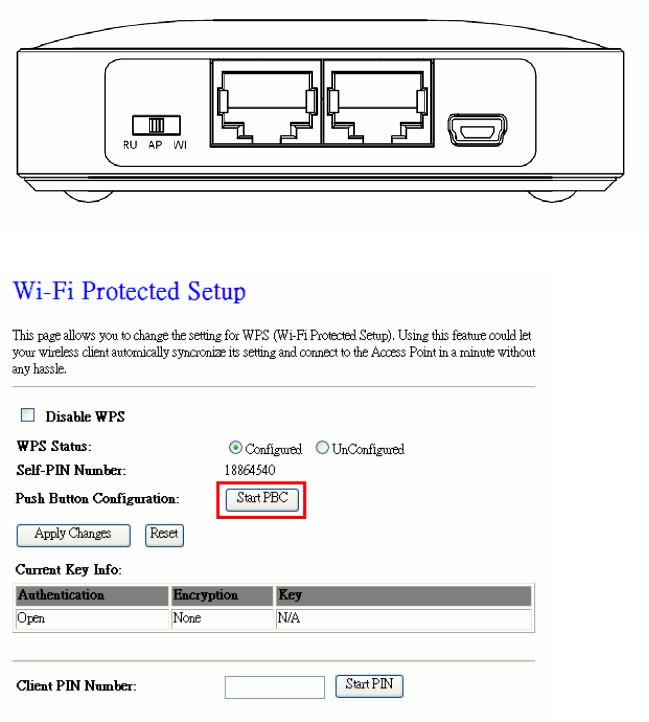
Version 1.0.15
109
(1.) Press the WPS button from 11N Mini Broadband Router or click Start PBC from
menu “Wi-Fi Protected Setup”, and waiting for the WPS wireless card setting.
or
(2.) Open the “Wireless Utility” of your wireless card, and click its “PBC” button, to
start auto pairing.
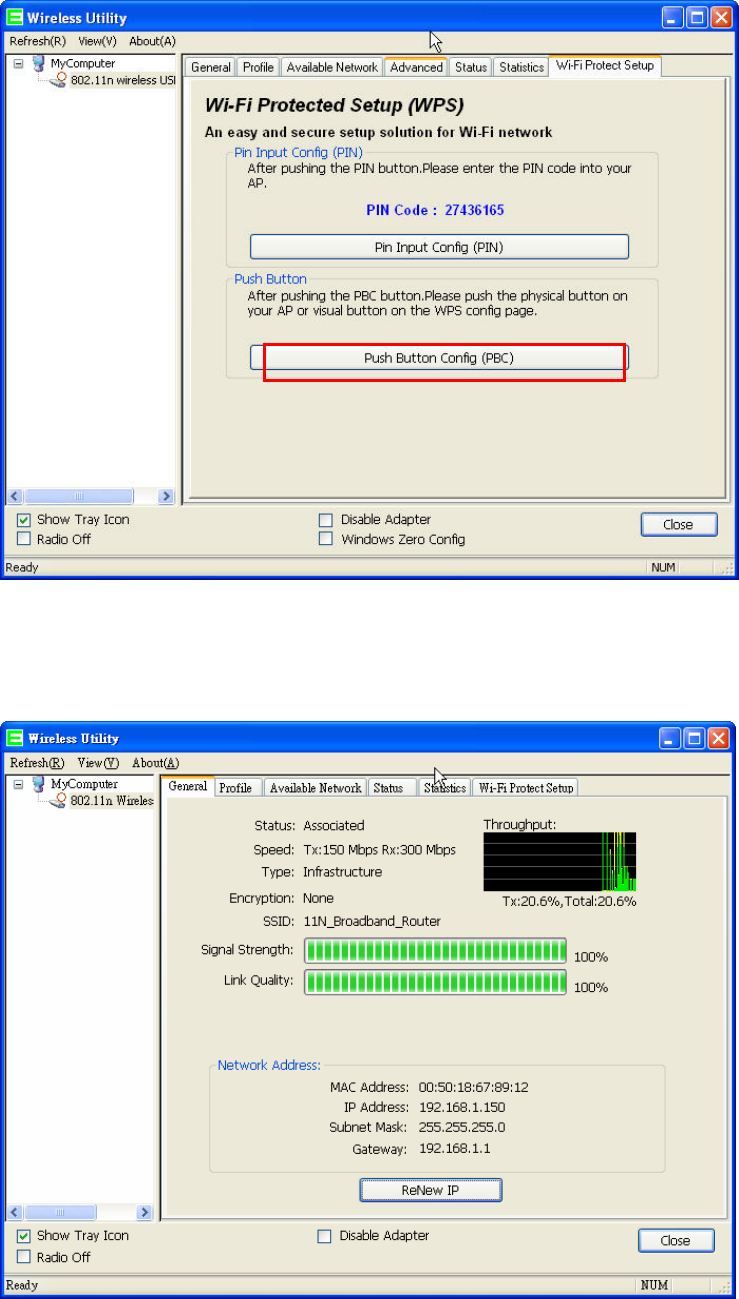
Version 1.0.15
110
(3.) While scanning is successful, the information of the wireless card appears in the
windows below.
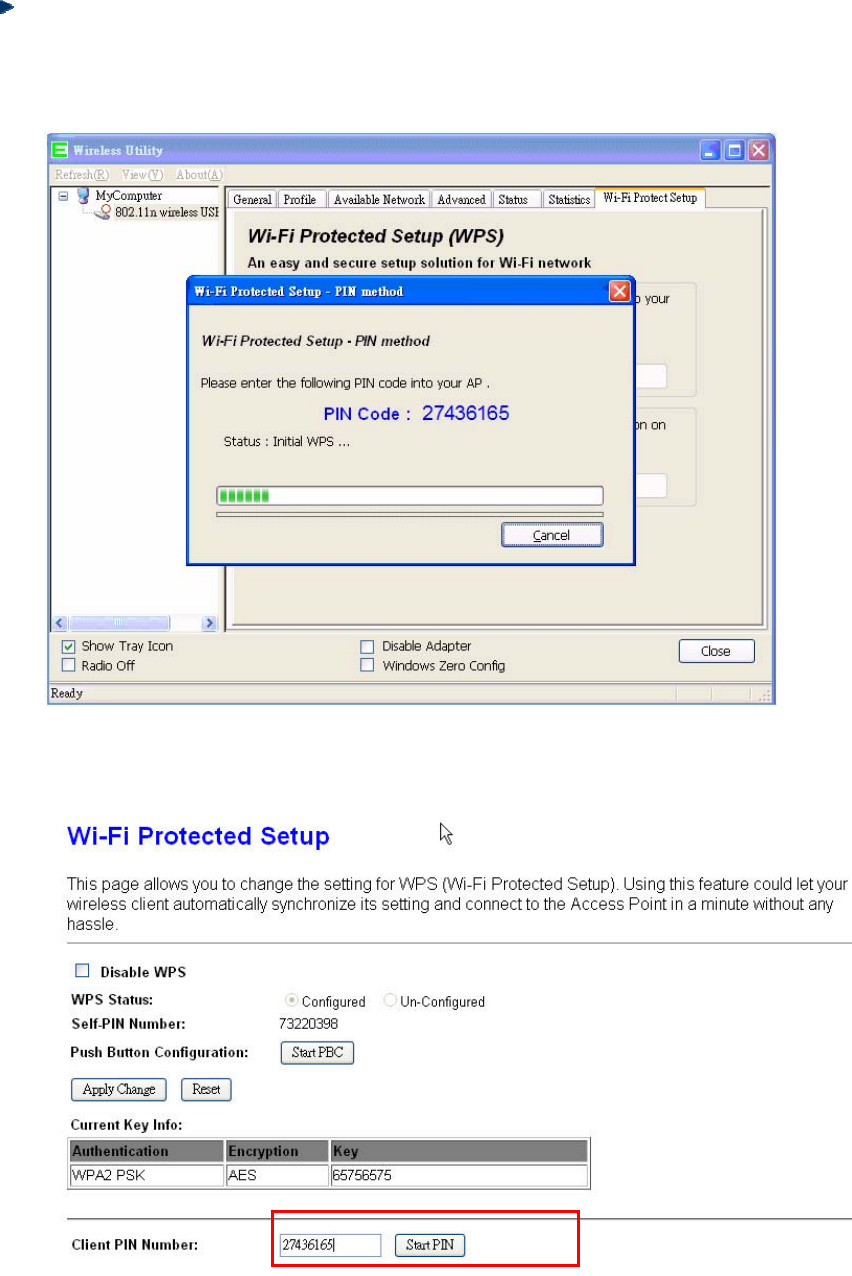
Version 1.0.15
111
Start PIN:
(1.) Open the “Wireless Utility” of your wireless card. Follow its PIN instruction to get
a new PIN number. Write it down.
(2.) Open menu “Wi-Fi Protected Setup” of 11N Mini Broadband Router , input the
PIN number from the wireless card then click Start PIN.
(3.) Back to “Wireless Utility” and press the “Start PIN” button to complete the
auto-paring process.
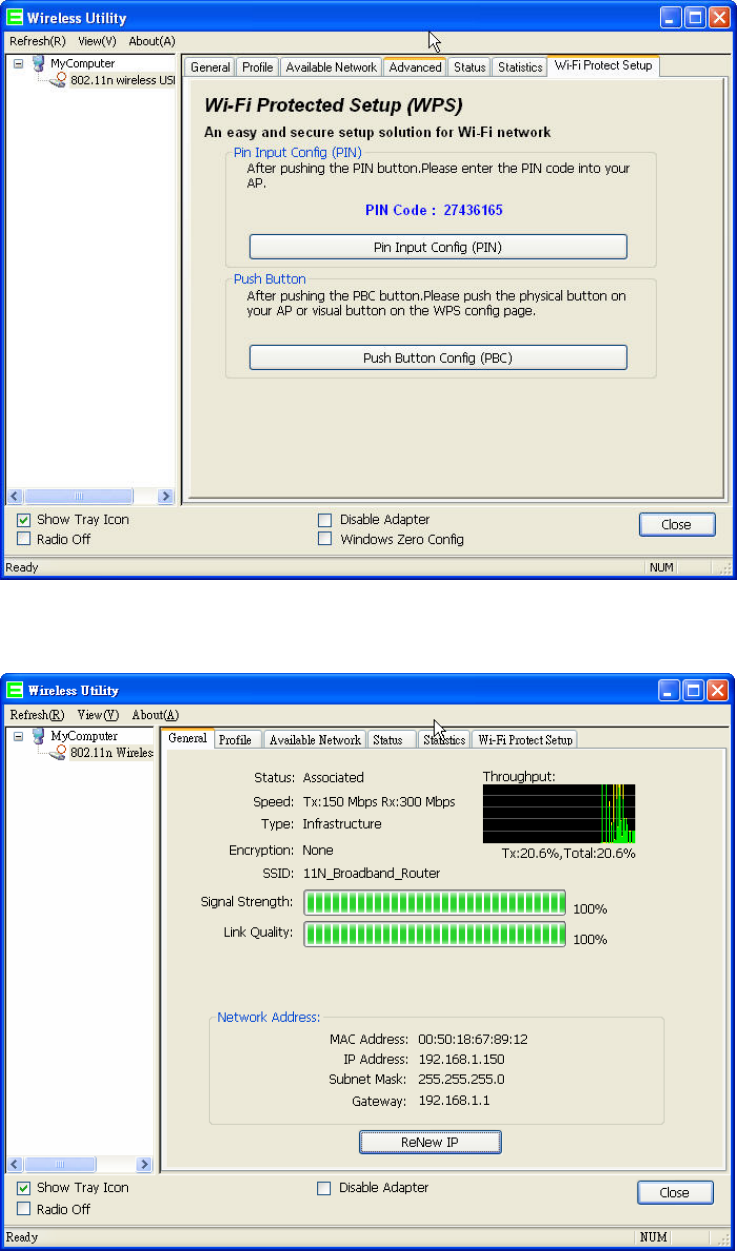
Version 1.0.15
112
(4.) When you can see the IP information below, the connection is established
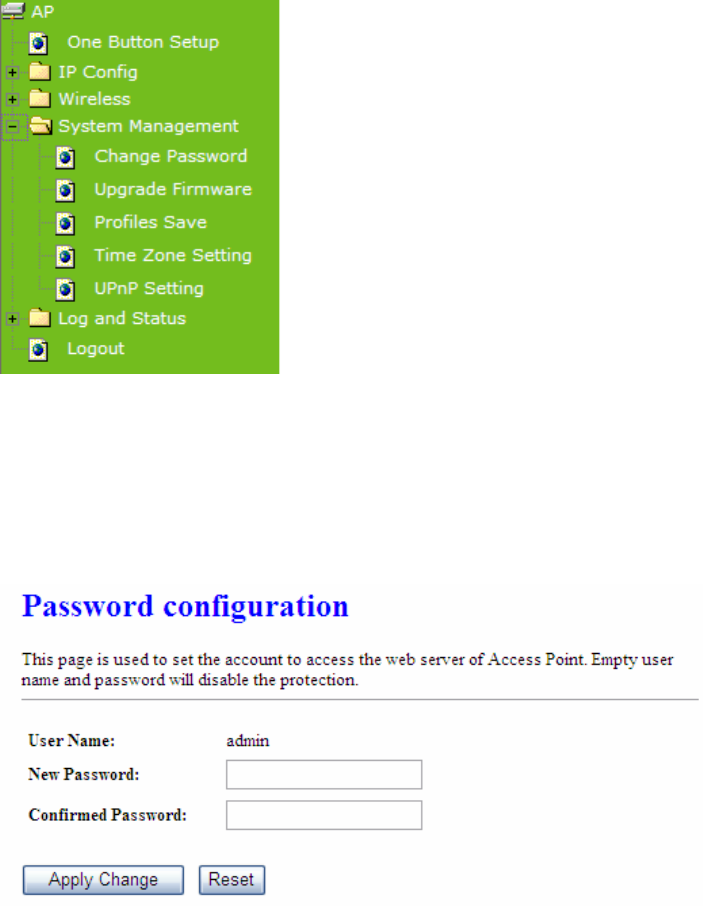
Version 1.0.15
113
6.3 System Management
11N Mini Broadband Router provides system management including password changing,
firmware upgrade, time setting, user’s account setting and other detail settings. Following is
detail explanation for each.
6.3.1 Change Password
Users can set or change their password in this section.
1. New Password
Enter the new password you want to change.
2. New Password (Confirm)
Enter the new password again for confirming.
3. Apply Changes & Reset
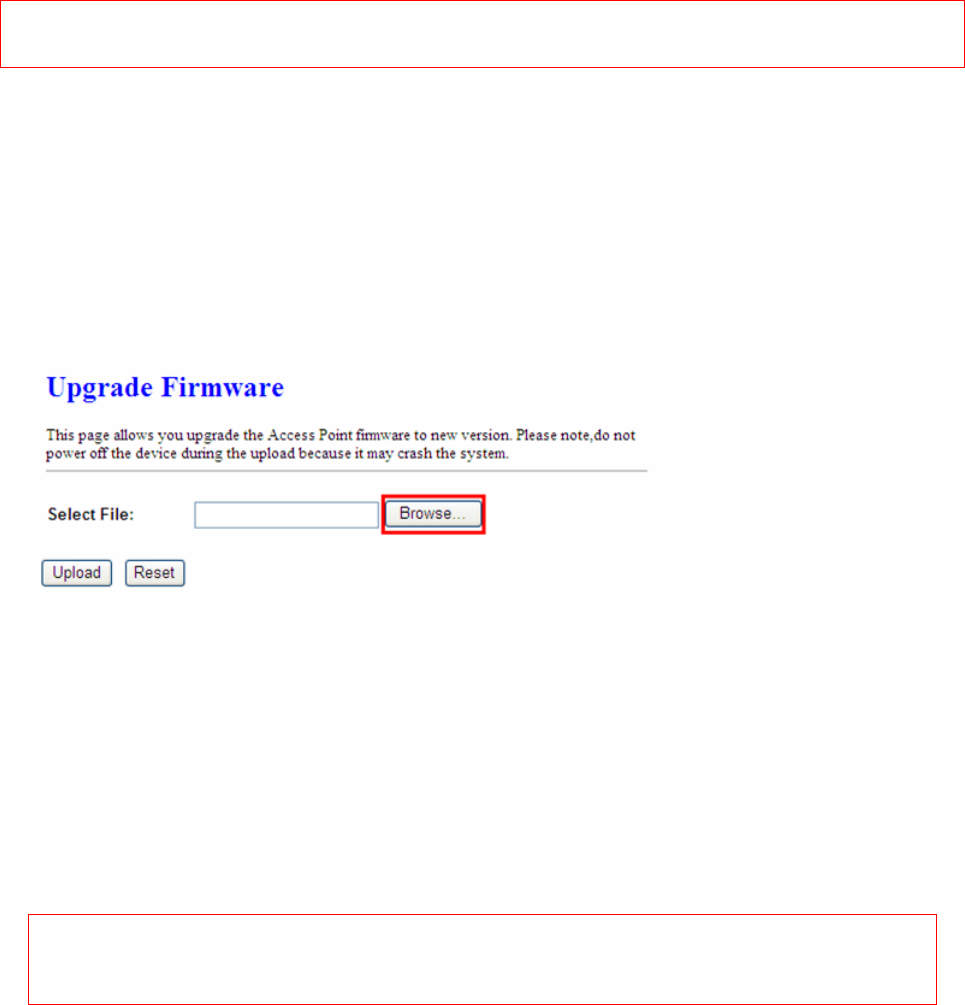
Version 1.0.15
114
Click on Apply Changes to save the setting data. Or you may click on Reset to clear all the
input data.
Note: 1. Only the password can be changed, the user name for administrator is admin and not to be changed.
2. If you forget administrator’s password, please reset 11N WLAN Mobile Server Router to default setting by
pressing the “Reset” button on the rear panel over 10 seconds. And the password will return to admin.
6.3.2 Upgrade Firmware
There is certain risk while upgrading firmware. Upgrading firmware is not recommended
unless the significant faulty is found. You can upgrade the firmware of 11N Mini Broadband
Router on this page. Make sure the firmware you want to use is on the local hard drive of
the computer. Click Upgrade Firmware to proceed.
1. Update Firmware
Click on Browse… button to search your local hard drive and locate the firmware to be
used for update.
2. Upload & Reset:
Click Upload to upgrade the firmware or Reset to restore to factory default Settings
Note: 1. To prevent the firmware upgrading interrupted by other wireless signals and caused failure. We
recommend using wired connection to do the upgrading.
2. Before upgrading the firmware, please remove any USB device which connected with this router.
3. The firmware upgrade will not remove your previous settings.
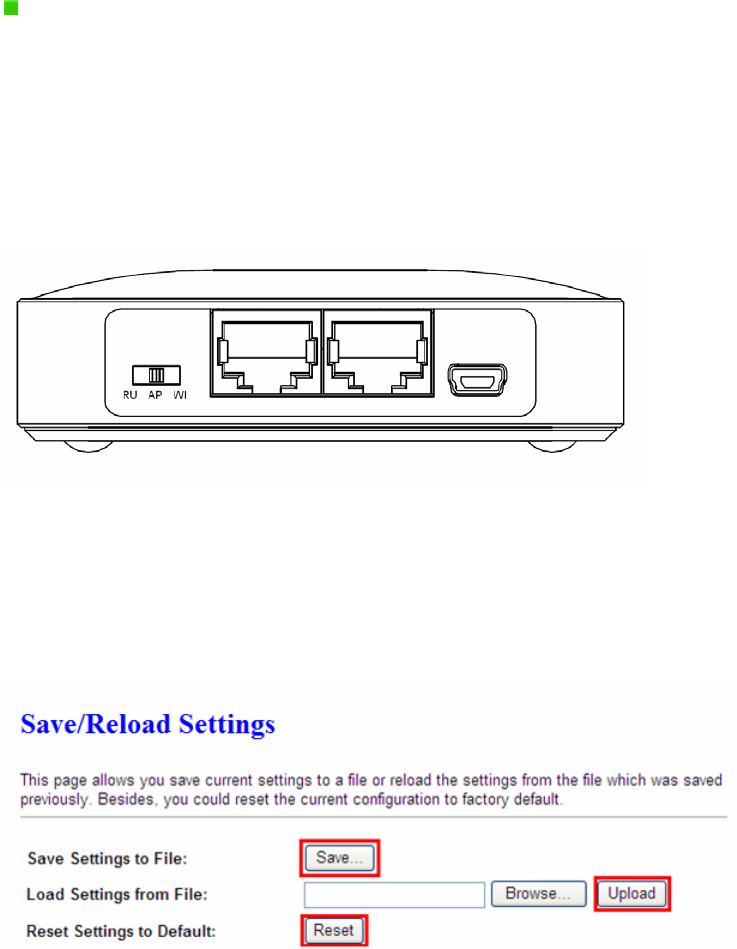
Version 1.0.15
115
Reset button:
On the back of this router, there is a reset button. If you can not login the administrator page
by forgetting your password; or the router has problem you can’t solve. You can push the
reset button for 10 seconds with a stick. The router will reboot and all settings will be restored
to factory default settings. If the problem still exists, you can visit our web site to see if there is
any firmware for download to solve the problem.
6.3.3 Save / Reload Settings
To back up the current configuration setting or load the backup data, also you can restore 11N
Mini Broadband Router to default setting by this function.
1. Save Settings To File
Step 1. Click on Save button for saving the configuration setting into assigned
location.
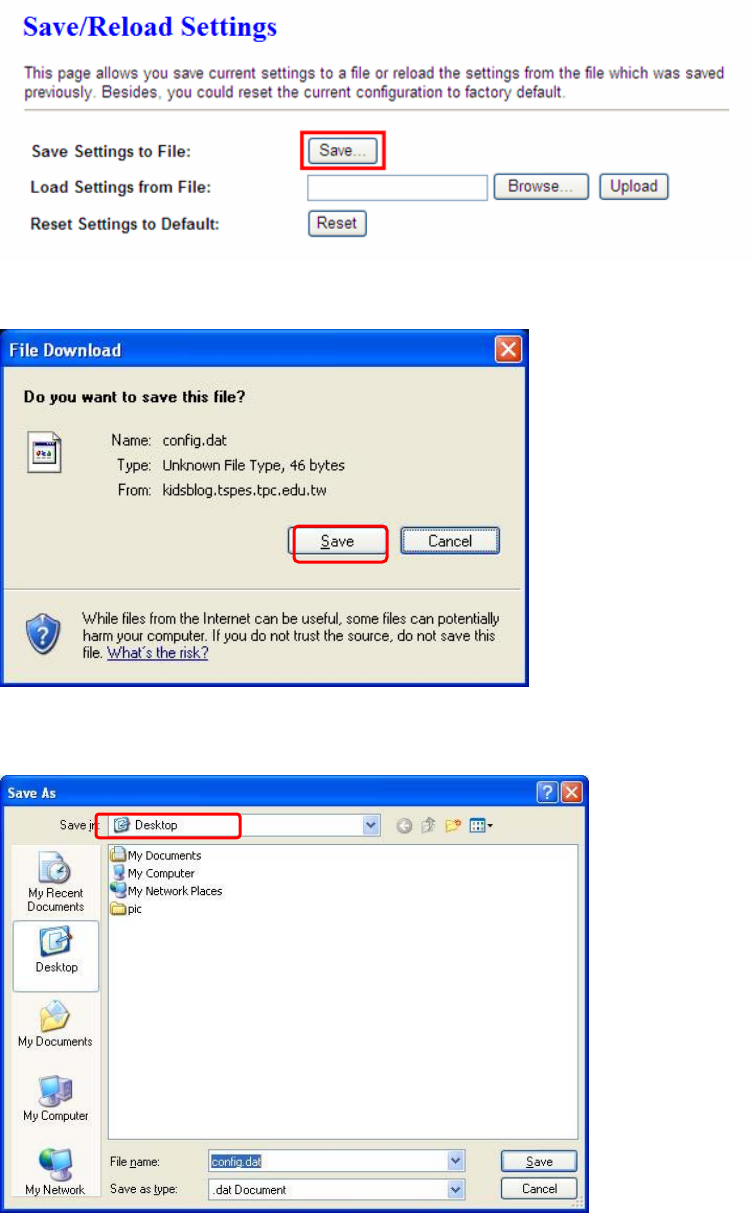
Version 1.0.15
116
A pop window will show up and ask to save config.dat file.
Step 2. Please select the location, for example: the desktop.
Step 3. The file you just saved will appear on the desktop.
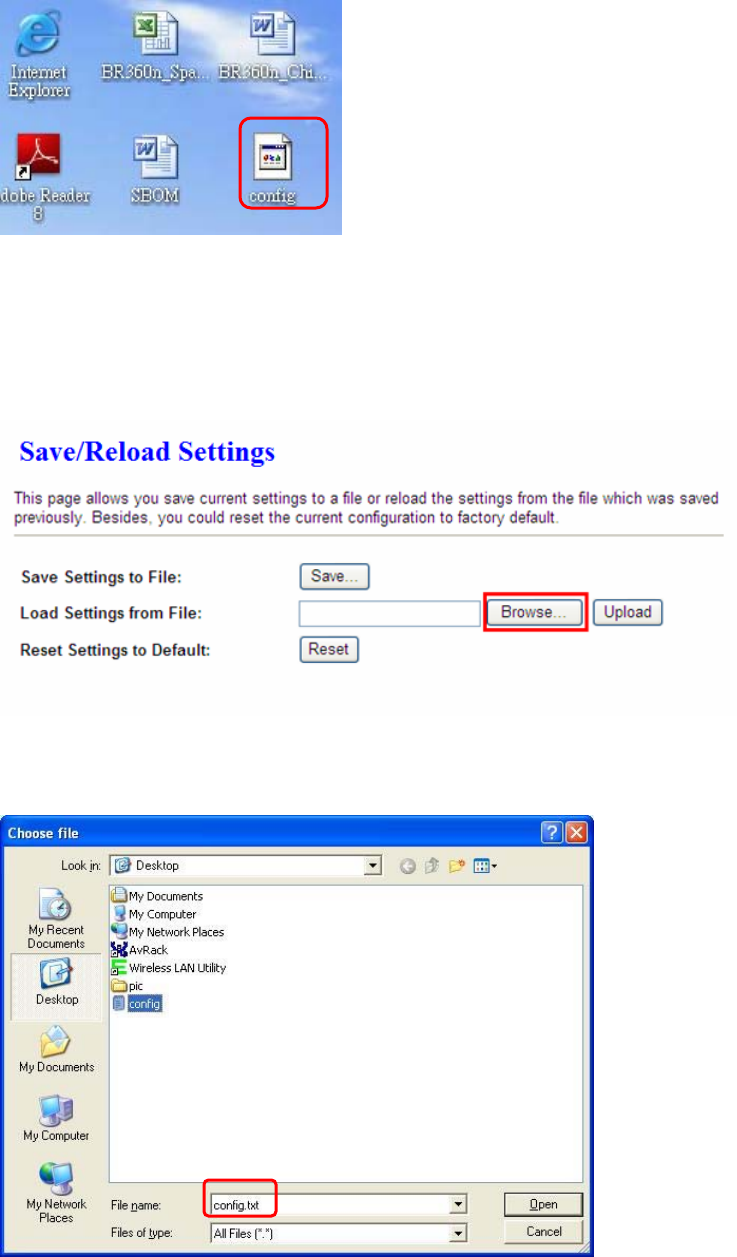
Version 1.0.15
117
2. Load Settings From File
Step 1. Click on “Browse…” button for searching the saving configuration from hard
drive, and then click on Upload button to load all the settings into the router.
Step 2. Select the config.dat file.
Step 3. Click Upload to retrieve.
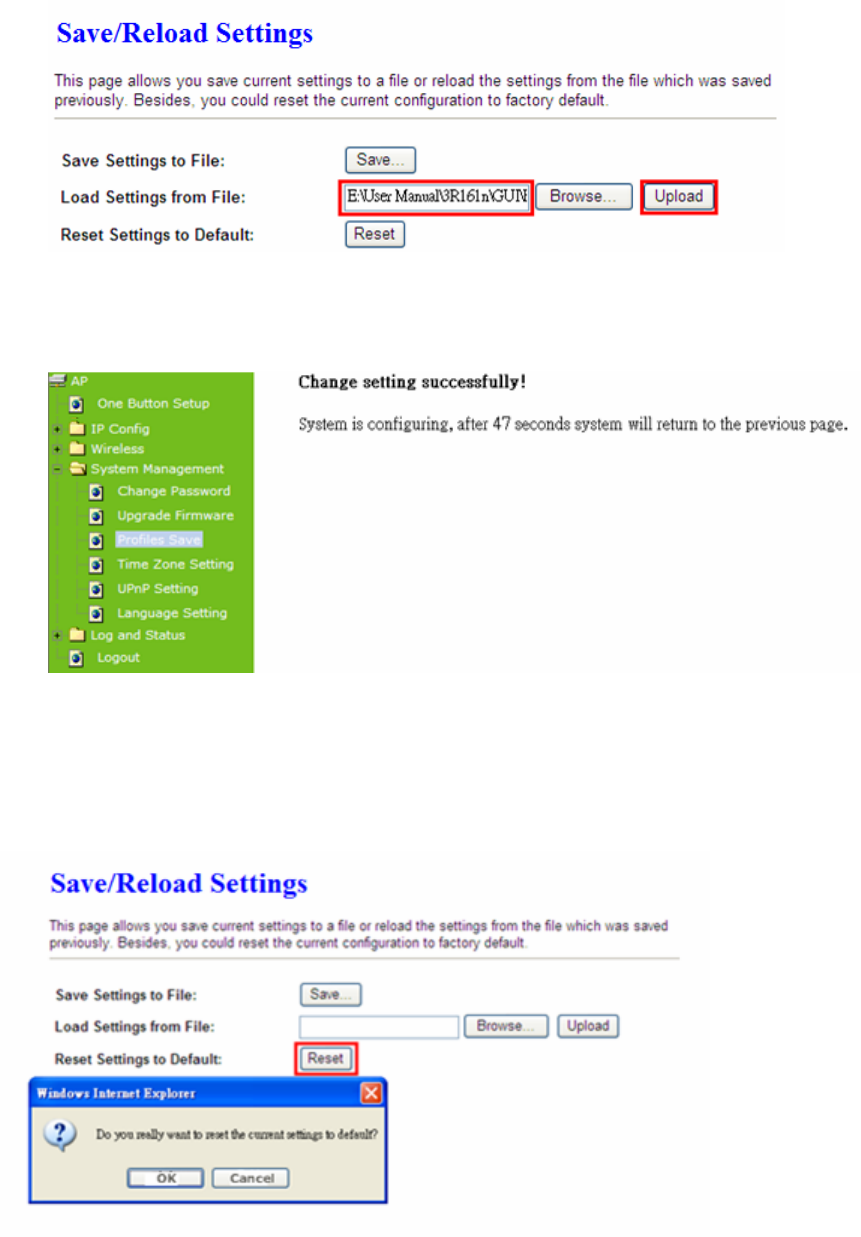
Version 1.0.15
118
Step 4. When you see the screen below, the updating is completed. Please click OK
to return to the main menu.
3. Reset Setting to Default
After you have tried other methods for troubleshooting your network, you may choose to
restore 11N Mini Broadband Router to the factory default settings.
When you see the screen below, the resetting is completed. Please click OK and return to the
main menu.
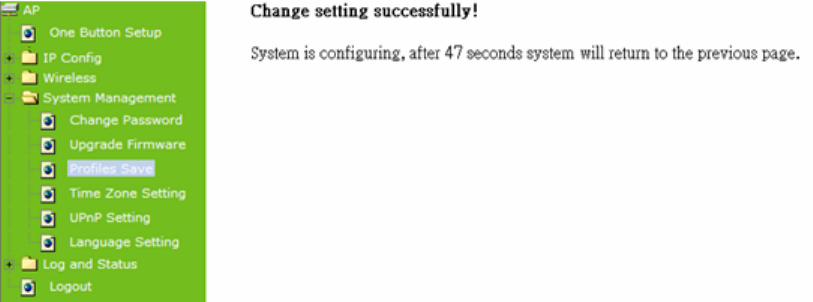
Version 1.0.15
119
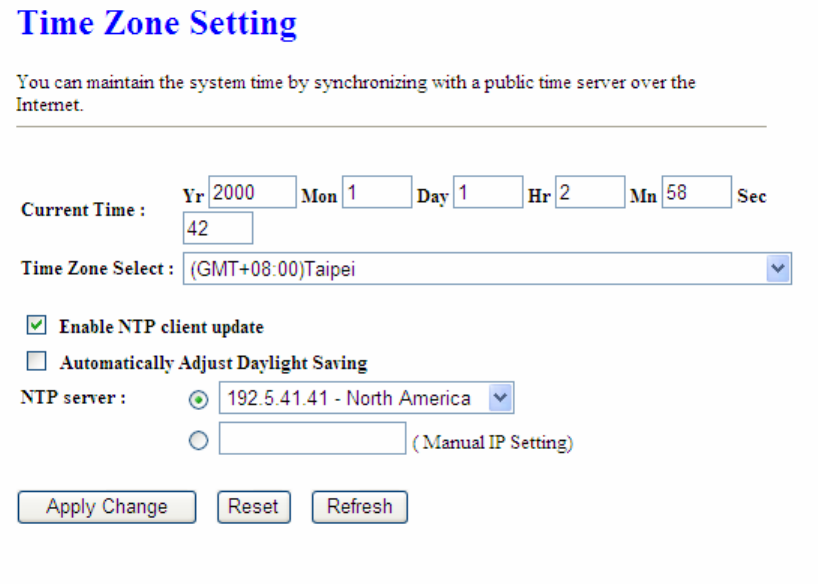
Version 1.0.15
120
6.3.4 Time Zone Setting
The System time is the time used by 11N Mini Broadband Router for scheduling services.
You can manually set the time or connect to a NTP (Network Time Protocol) server. If a NTP
server is set, you will only need to set the time zone. If you manually set the time, you may
also set Daylight Saving dates and the system time will automatically adjust on those dates.
1. Current Time
Users can input the time manually.
2. Time Zone Select
Select your time zone location from the drop-down list.
3. Enable NTP client update
Check to enable NTP client update.
4. Automatically Adjust Daylight Saving
If you are in daylight saving time area, please enable this item.
5. NTP server
Please select the NTP server from the pull-down list, or you can enter the NTP server IP
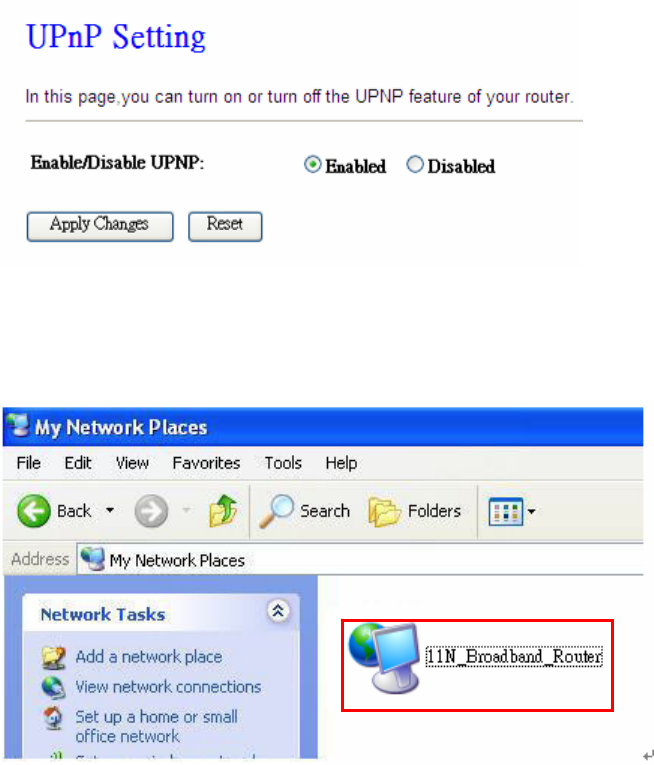
Version 1.0.15
121
address manually.
6. Apply Changes & Reset & Refresh
Please click on Apply Changes to save the setting data. Or you may click on Reset to clear
all the input data. Or you may click on Refresh to update the system time on the screen.
6.3.5 UPnP Setting
UPnP (Univsersal Plug and Play) allows users to connect their UPnP-enabled Mini Router,
printer server and other devices right to the network with zero-configuration, meaning easier
setup for installing the device on the network. The automatic discovery feature enables the
device to obtain an IP address, present and describe itself to other devices and PCs on the
network without having to install drivers, but to configure and use those devices.
After enabling UPNP, click My Network Places, and user can open the web GUI by just
clicking on the Internet Gateway Device icon.
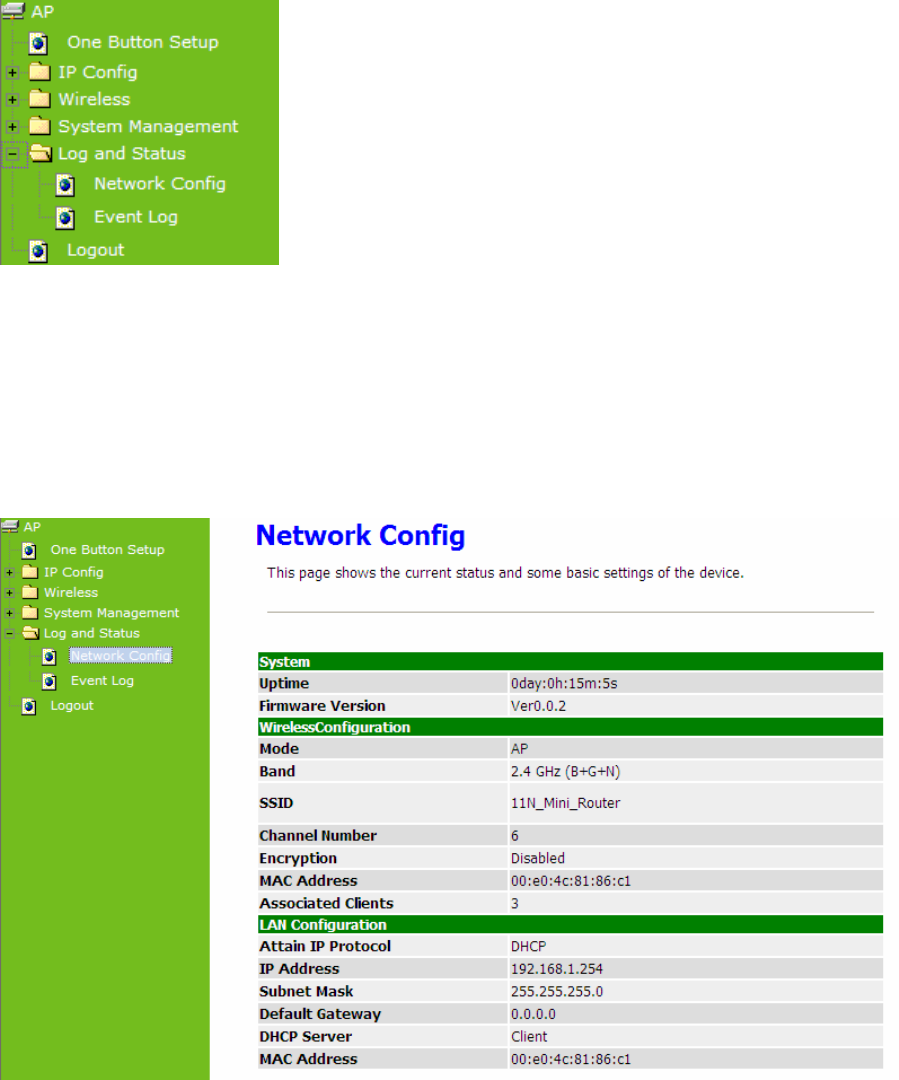
Version 1.0.15
122
6.4 Log & Status
11N Mini Broadband Router provides the log list and connection status for user to check.
6.4.1 Network Config
Network Configuration shows the firmware version and the connection status of LAN, WAN
and Wireless.
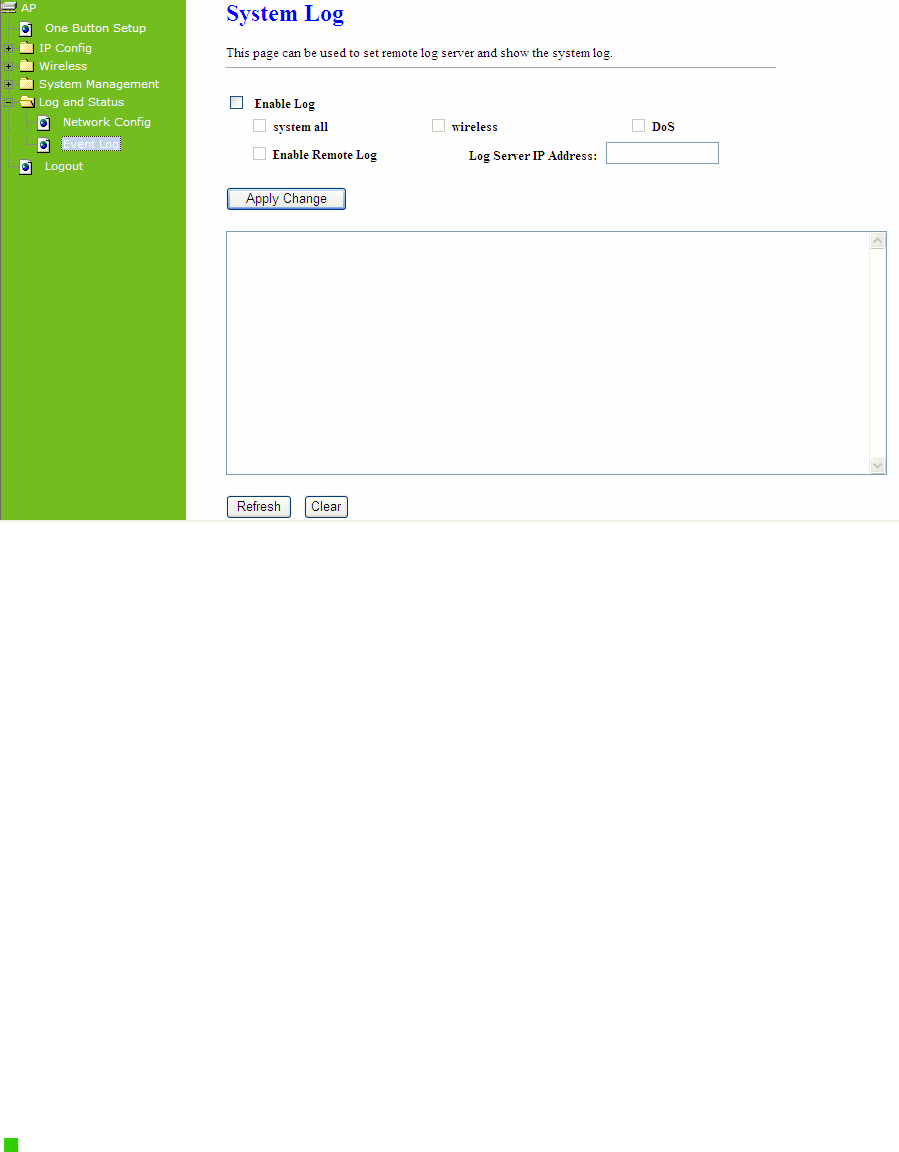
Version 1.0.15
123
6.4.2 Event Log
11N Mini Broadband Router provides system logs for review.
1. Enable Log
Select Enable Log to record the system log
2. system all, wireless & DoS
Select Wireless, DoS or system all to record
3. Enable Remote Log
You may choose to enable the remote event log or not.
4. Log Server IP Address
Please input the log server IP Address.
5. Apply Changes & Refresh & Clear
Click on Apply Changes to save the setting data. Click on Refresh to renew the system time,
or on Clear to clear all the record.
After clicking Apply Changes to record the event log, it will be shown as the example
below.
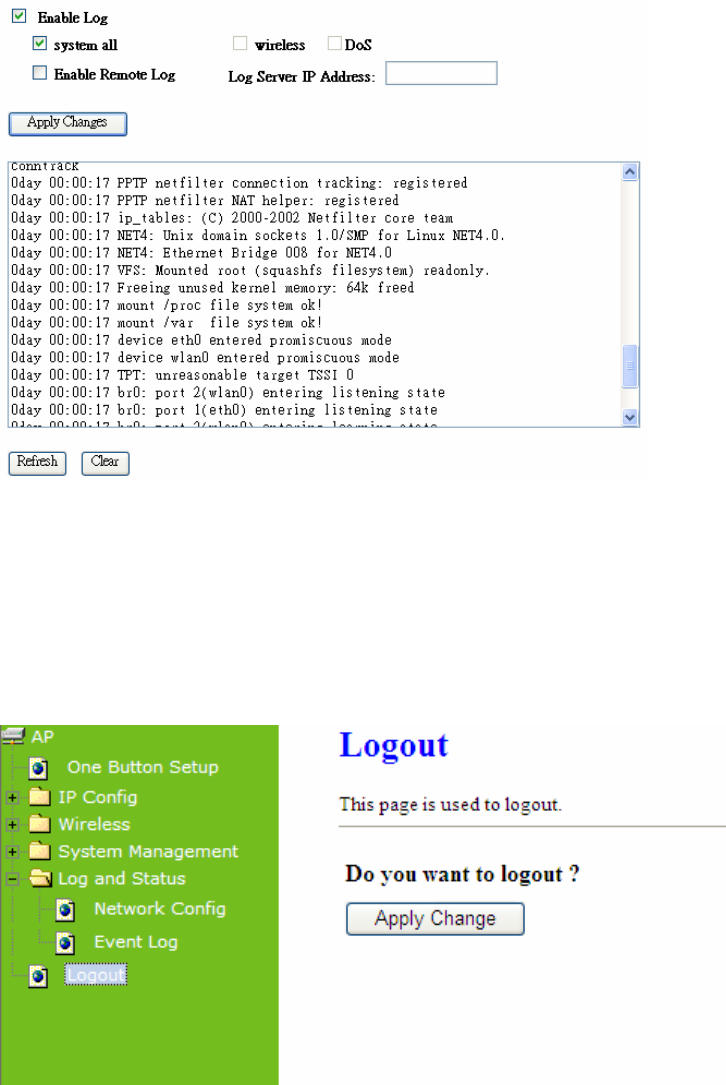
Version 1.0.15
124
6.5 Logout
Click Logout on the bottom menu to exit and go back to GUI login home page.
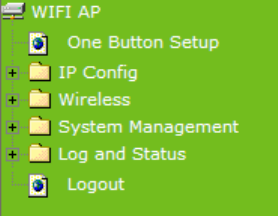
Version 1.0.15
125
Chapter 7 Advance Configuration for WiFi AP Mode
7.1 IP Configuration
This function allows you to add routing rules into 11N Mini Broadband Router , including LAN.
7.1.1 LAN Setup
Use this page to set up the local IP address and subnet mask for your router. Please select
LAN under the IP Config menu and follow the instructions below to enter the LAN setting
page to configure the settings you want.
7.1.2 LAN Interface Setup
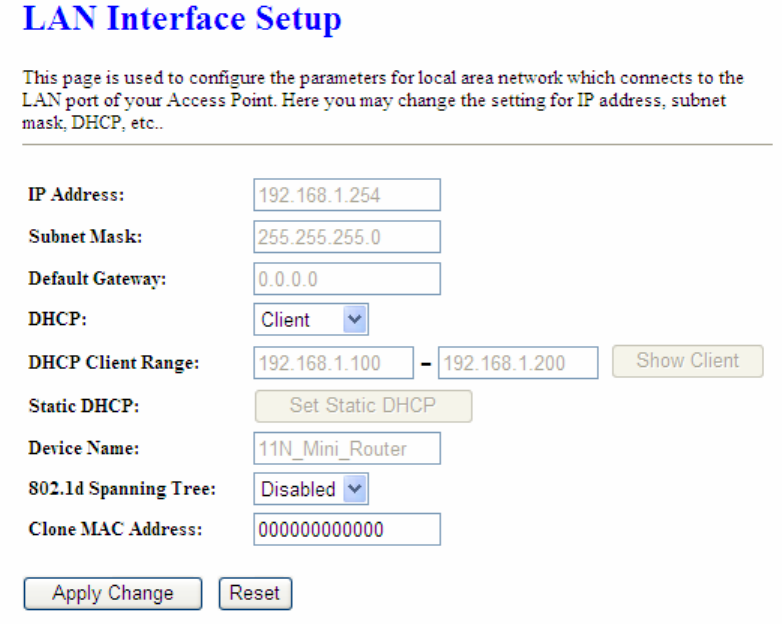
Version 1.0.15
126
1. IP Address
The default value of LAN IP address is 192.168.1.254 for this router.
2. Subnet Mask
Input Subnet Mask, normally it is 255.255.255.0.
3. Default Gateway
Input ISP Default Gateway Address. If you don’t know, please check with your ISP.
4. DHCP
Enable or disable DHCP services. The DHCP server will automatically allocate an unused IP
address from the IP address pool to the requesting computer if enabled.
5. DHCP Client Range
Define the DHCP client range and then the DHCP server will assign an IP to the requesting
computer from this range. The Show Client will display every assigned IP address, MAC
address, and expired time. The default range is 192.168.1.100 - 192.168.1.200.
6. 802.1d Spanning Tree
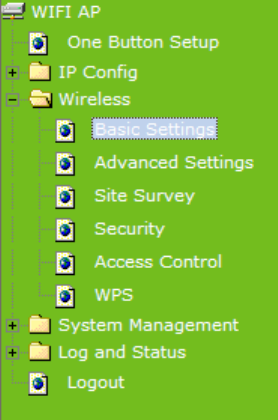
Version 1.0.15
127
IEEE 802.1d Spanning Tree Protocol (STP) is a link layer network protocol that ensures a
loop-free topology for any bridged LAN. The main purpose of STP is to ensure that you do not
create loops when you have redundant paths in your network. Loops are deadly to a network.
7. Clone MAC Address
Copy the MAC address from the device you had registered to your ISP if your ISP asks for
the specific MAC Address.
8. Apply Changes & Reset
Click on Apply Changes to save the setting data. Or you may click on Reset to clear all the
input data.
7.2 Wireless Setup
Please select Wireless under the main menu.
7.2.1 Wireless Basic Settings
Follow the instructions to configure the Wireless settings.
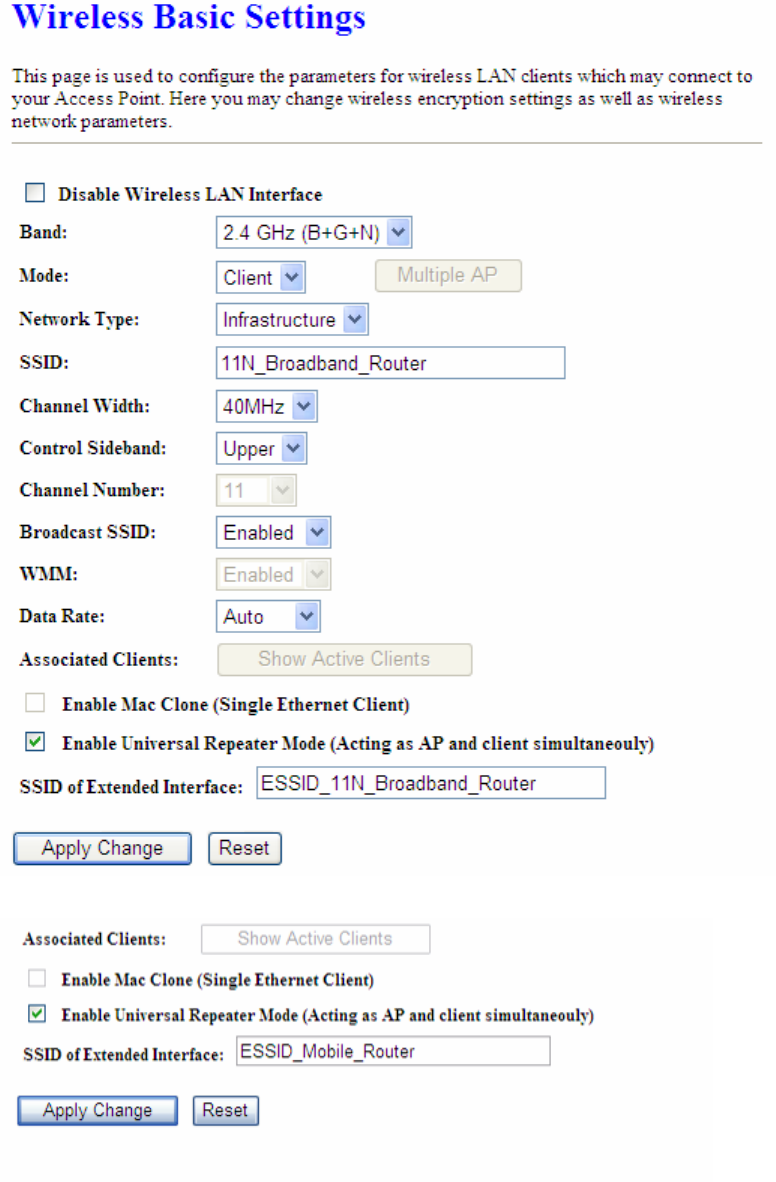
Version 1.0.15
128
1. Disable Wireless LAN Interface
Select Disable Wireless LAN Interface to turn off the wireless function.
2. Band
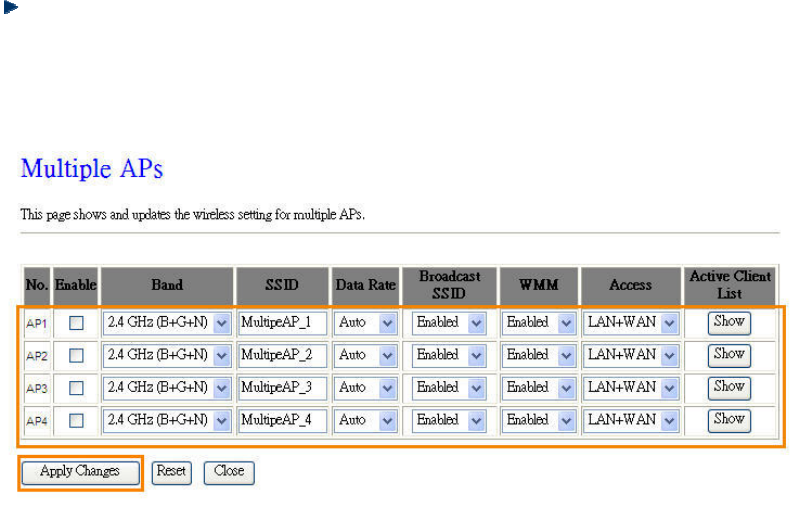
Version 1.0.15
129
This field indicates the 802.11x interface mode. For example, “2.4GHz(G)” prevents the
802.11b clients from accessing the router. “2.4GHz(B+G)” allows both 802.11b and 802.11g
clients to access the router. There are 6 options, 2.4 GHz (B/G/N/B+G/G+N/B+G+N) from the
drop down list.
3. Mode
Select AP, WDS, or AP+WDS to allow or disallow the wireless operation.
Multiple APs
Click Multiple APs to set up 4 different SSIDs to deploy a shared WLAN. Users can add
or limit the properties for each SSID, increasing the flexibility and efficiency of the
network.
(1.) Enable: check it for enable or not.
(2.) Band: select the frequency from the drop down list.
(3.) SSID: please enter different SSID in each class.
(4.) Data Rate: please select the data transmission rate.
(5.) Access: defined the access type.
a. LAN+WAN: the client can access to the Internet and connect to 11N Mobile
router’s GUI to setup.
b. WAN: the client can only access to the Internet.
(6.) Active Client List: display the properties of the client which is connecting
successfully.
(7.) Apply Changes: Please click Apply Changes to initiate or click Reset to clear all
the input data.
Version 1.0.15
130
4. Network Type:
Please select “Infrastructure” or “Ad hoc.” The default is “Infrastructure.” The selection is
disabled when wireless mode is selected to AP.
5. SSID:
Please input your wireless network name. Default is “11N_Mini_Router”.
6. Channel Width
Please select “20MHZ” or “40MHZ” channel width to change the transmission channels.
7. ControlSideband
Setting the Sideband "Upper" or "lower.”
8. Channel Number
Please select your wireless network channel. There are Auto, 2~11.
9. Broadcast SSID
Enable or disable the SSID broadcast function. Disable this feature can provide more security
of your WLAN.
10. Data Rate
Rate at which data can be communicated (bps); auto, 1M, 2M, 5.5M, 11M, 6M, 9M, 12M, 18M,
24M, 36M, 48M or 54M to be selected from the drop-down list.
11. Associated Clients
Check the WiFi ISP connectors and the connecting status.
12. Enable Mac Clone (Single Ethernet Client)
Copy the MAC Address for identity of some ISPs.
13. Enable Universal Repeater Mode (Acting as AP and Client simultaneously)
Enable Universal Repeater Mode, 11N Mini Broadband Router will act as a wireless AP
and AP client at the same time, and able to link to another AP.. It uses AP client function to
connect to a Root AP (any AP) and uses AP function to service all wireless stations within its
coverage. All the stations within the coverage of 11N Mini Broadband Router can be bridged
to the Root AP. It can help user to extend the coverage of wireless network.
After checking Enable Universal Repeater Mode, please input the ESSID. The default is
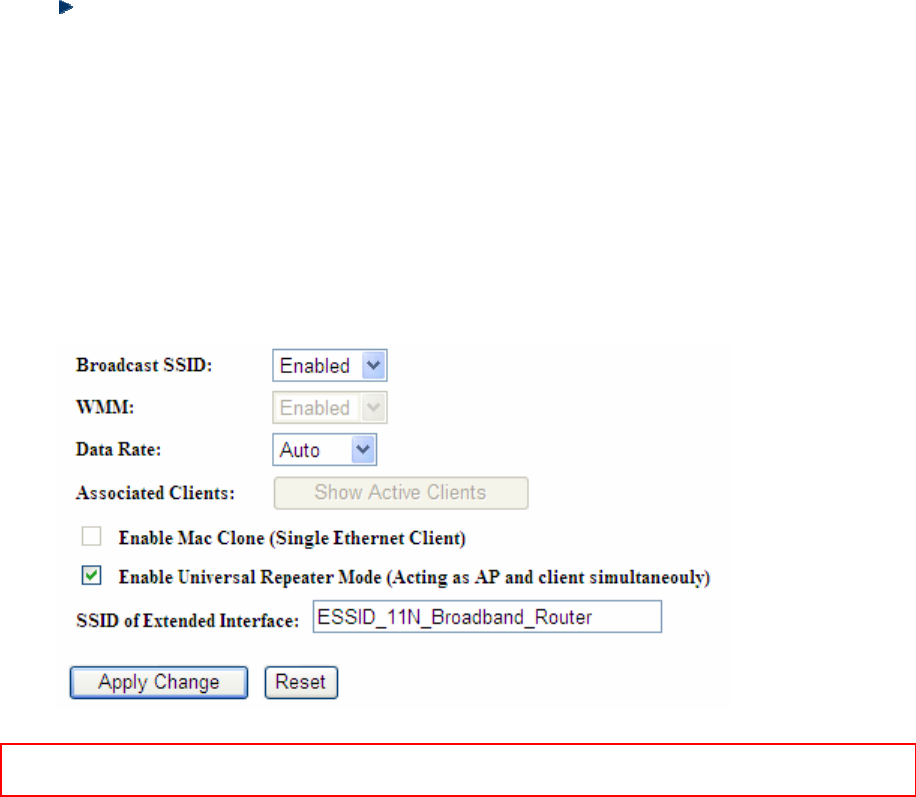
Version 1.0.15
131
ESSID_Mobile_Router.
How to Enable URM (Universal Repeater Mode)
User could enable URM in wireless basic setting page as shown in following figures.
Step 1. Get back to menu “Network Config” and write down the SSID, channel and
security.
Step 2. Setting the same SSID, channel and security you got form “Network Config”
and Click on Apply Changes to save the setting
Note: The DHCP server should be disabled under menu “LAN Interface Setup” and then the URM could be
enabled.
Step 3. Check the AP connectors and the Wireless connecting status.
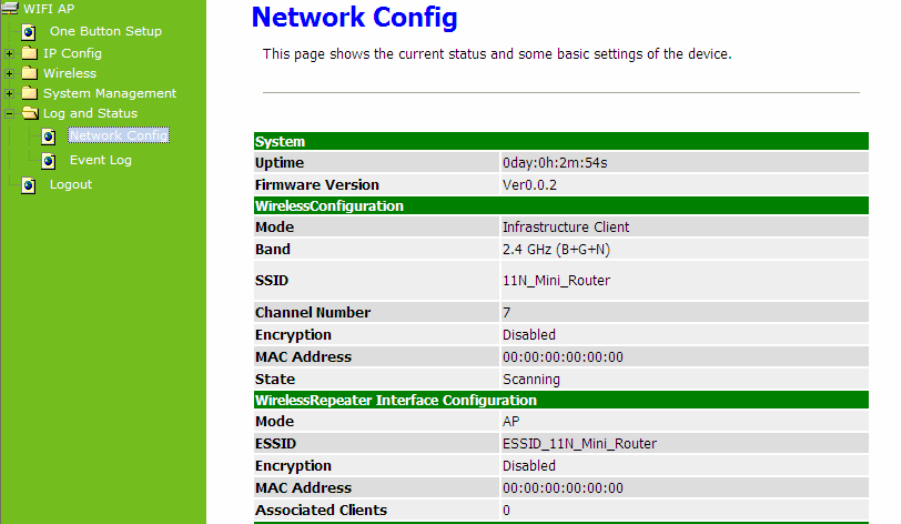
Version 1.0.15
132
14. SSID of Extended Interface
When mode is set to “AP” and Universal Repeater Mode is enabled, user should input SSID
of another AP (the upper level device) in the field of SSID of Extended Interface.
15. Apply Changes & Reset
Click on “Apply Changes” to save the setting data. Or you may click on “Reset” to clear all
the input data.
7.2.2 Wireless Advanced Settings
Please follow the instructions to configure the Wireless settings.
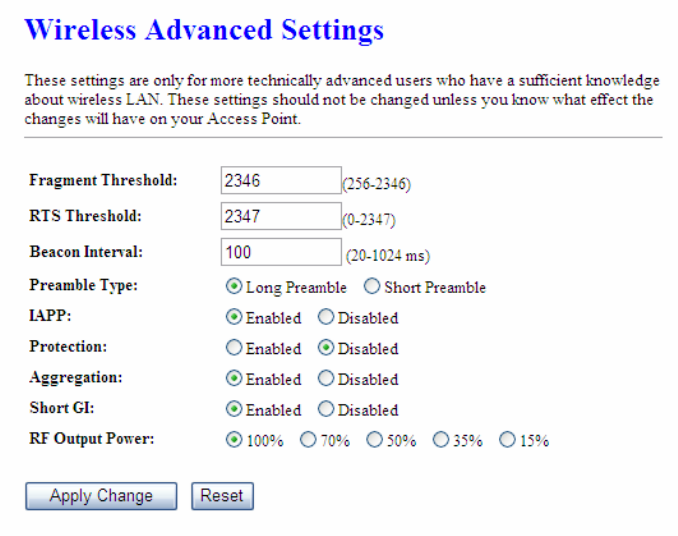
Version 1.0.15
133
1. Fragment Threshold
To identify the maximum length of packet, the overflow packet length wil be fragmentized.
The allowed range is 256-2364, and default length is 2346 bytes.
2. RTS Threshold
This value should remain at its default setting of 2347. The range is 0~2347. Should you
encounter inconsistent data flow, only minor modifications are recommended. If a network
packet is smaller than the present RTS threshold size, the RTS/CTS mechanism will not be
enabled. The router sends Request to Send (RTS) frames to a particular receiving station
and negotiates the sending of a data frame. After receiving an RTS, the wireless station
responds with a Clear to Send (CTS) frame to acknowledge the right to begin transmission.
Fill the range from 0 to 2347 into this blank.
3. Beacon Interval
Beacons are packets sent by an access point to synchronize a wireless network. Specify a
beacon interval value. The allowed setting range is 20-1024 ms.
4. Preamble Type
The preamble (also called “a header”) is a section of data at the head of a packet that
contains information that wireless devices need when they send and receive packets. Short
preambles improve throughput performance, but some wireless devices require long
preambles. Select the suitable preamble as short or long preamble.
Version 1.0.15
134
5. IAPP
Inter Access Point Protocol. Allow seamless roaming between Access Points in your
wireless network. Coupled with superior RF performance
6. Protection
Select to enable the wireless protection or not.
7. Aggregation
Data aggregation can reduce the amount of data routed through the network, and increasing
throughput.
8. Short GI
Enabling the Short Guard Interval increases the wireless transmission.
9. RF Output Power
User can adjust the RF output power to get the best wireless connection. There are 5 power
types available: 100%, 70%, 50%, 35%, and 15%.
10. Apply Changes & Reset
Click on “Apply Changes” to save the setting data. Or you may click on “Reset” to clear all
the input data.
7.2.3 Wireless Site Survey
This function provides users to search existing wireless APs or wireless base stations from
ISP. You can connect to a wireless AP manually in WiFi AP mode. The designed AP will
appear on SSID column in Wireless Basic Setup page.
Please click on Refresh to refresh the list. Click Connect after select an existing AP to
connect.
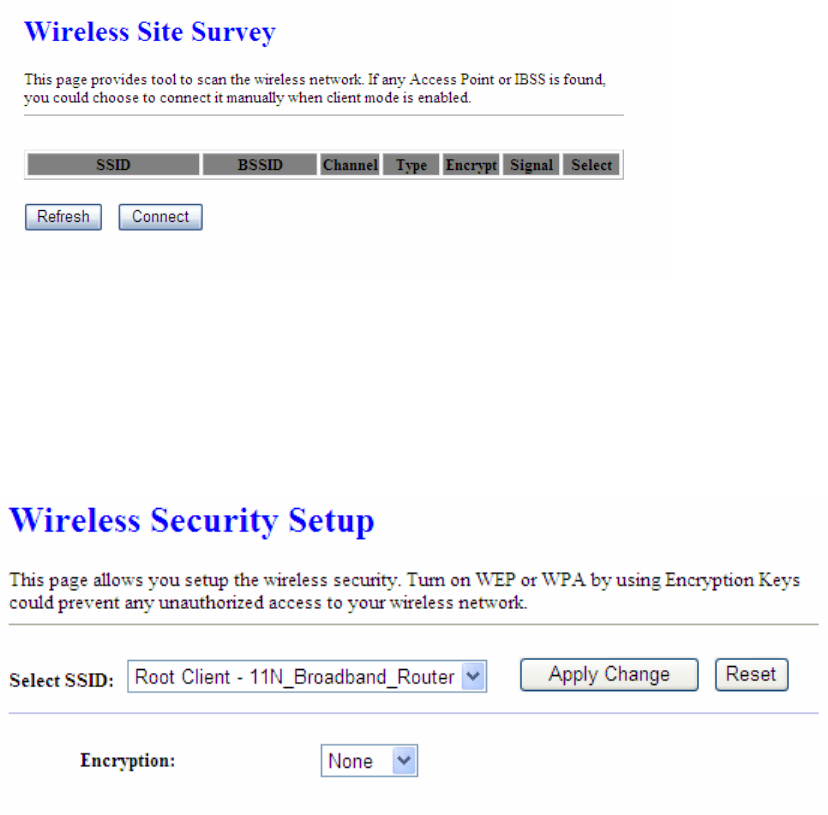
Version 1.0.15
135
7.2.4 Wireless Security Setup
4 encryption types can be selected here, please follow the instructions below for each.
1. Encryption – WEP
Enabling WEP can protect your data from eavesdroppers. If you do not need this feature,
select “None” to skip the following setting. 11N Mini Broadband Router supports both 64-bit
and 128-bit encryption using the Wired Equivalent Privacy (WEP) algorithm. Select the type
of encryption you want to use (64 or 128 bit) and configure one to four WEP Keys. The
“1280bit” method is more secure than the “64-bit”.
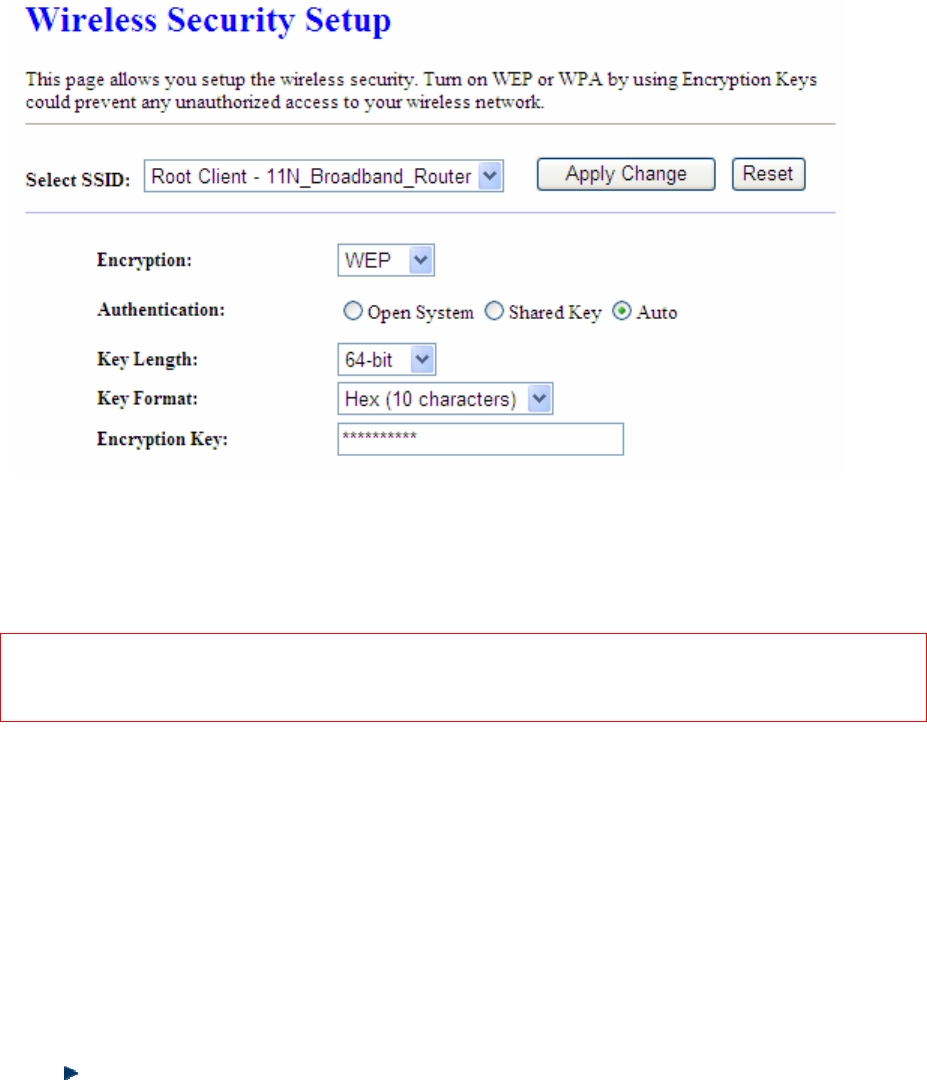
Version 1.0.15
136
Key Length: For 64bits WEP key, either 5 ASCII characters or 10 hexadecimal digitals
leading by 0x can be entered. For 128bits WEP key, either 13 ASCII characters or 26
hexadecimal digits leading by 0x can be entered.
Note: 128 bits WEP is most secure, but has more encryption/decryption overhead. Note that all wireless devices
must support the same WEP encryption bit size and have the same key. Four keys can be entered here, but
only one key can be selected at a time. The keys can be entered in ASCII or Hexadecimal. Select the item
from drop-down list you wish to use.
Encryption Key: At most four keys can be set. A WEP key is either 10 or 26
hexadecimal digits (0~9, a~f, and A~F) based on whether you select 64 bit or 128 bit in
the WEP drop-down list.
2. Encryption – WPA (WPA, WPA2 & WPA2 Mixed)
The WPA, WPA2 & WPA2 Mixed encrypt each frame transmitted from the radio using the
pre-shared key (PSK) which entered from this panel or a key got dynamically through
802.1x.
WPA Authentication Mode
Enterprise (RADIUS): Please input the port, IP address, and password of
authentication RADIUS Server.
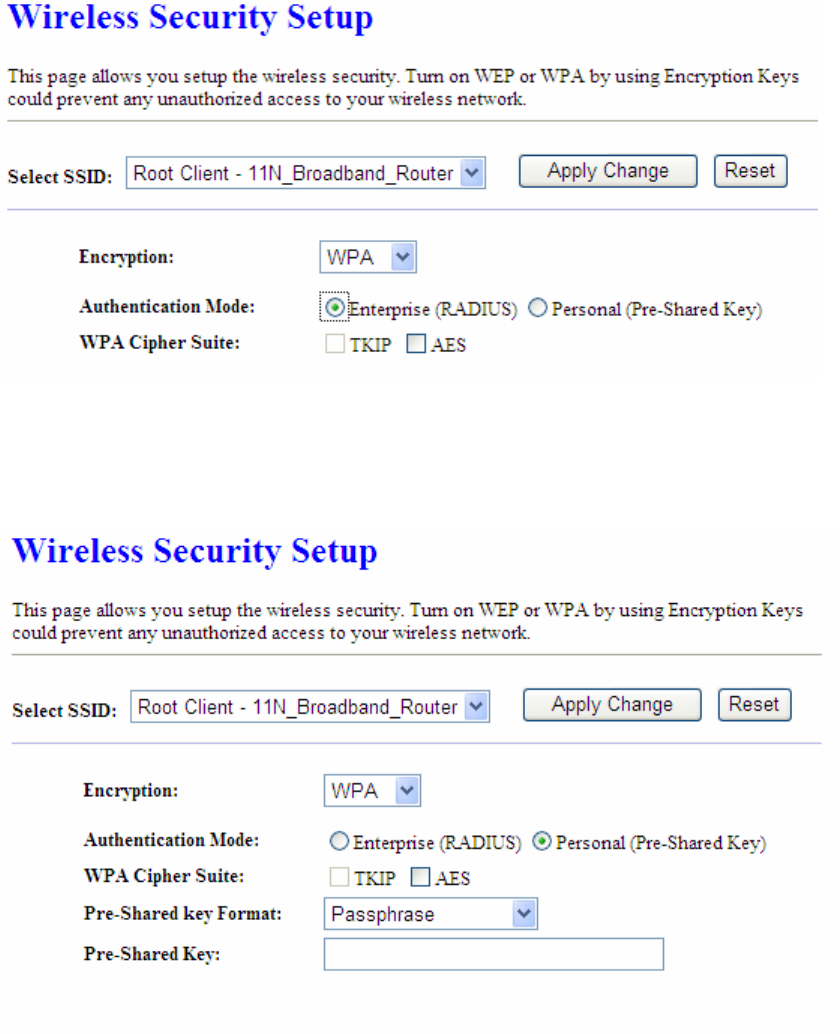
Version 1.0.15
137
Personal (Pre-Shared Key): Pre-Shared Key type is coding in ASCII, and the
length is between 8 to 63 characters. If the coding is in Hex, the key length is 64
characters.
3. Apply Changes & Reset
Click on Apply Changes to save the setting data. Or you may click on Reset to clear all the
input data.
7.2.5 Wireless Access Control
With the MAC address, you may allow or disallow the access to your AP.
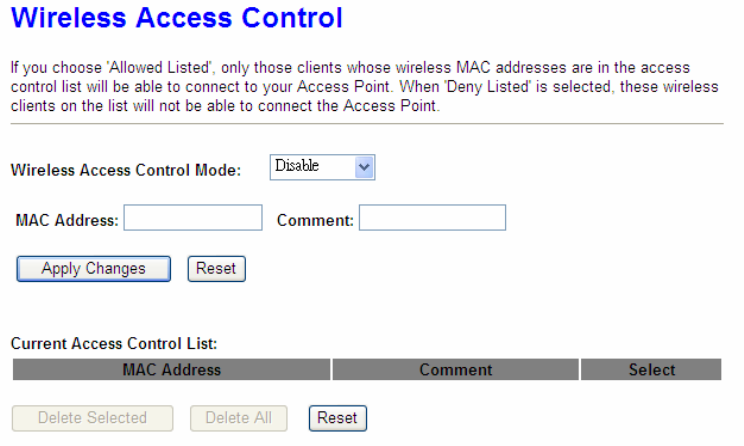
Version 1.0.15
138
1. Wireless Access Control Mode
“Allowed Listed” means only the MAC address listed on the allowed list can access to your
wireless network.
“Deny Listed” means the listed MAC Address are not allowed to linkto your wireless
network.
“Disable” for function disuse.
2. MAC Address
Please input the allowed or denied MAC address, for example, 001122334455.
3. Comment
You may input the comments for the set MAC Address.
4. Apply Changes & Reset
Click on “Apply Change” to save the setting data. Or you may click on “Reset” to clear all the
input data.
5. Current Access Control List
In this list, all the MAC info you input will be displayed.
6. Delete Selected and Delete All
Click on “Delete Selected” to erase the selected MAC address. Click on “Delete All” to erase
all the entered MAC Address.
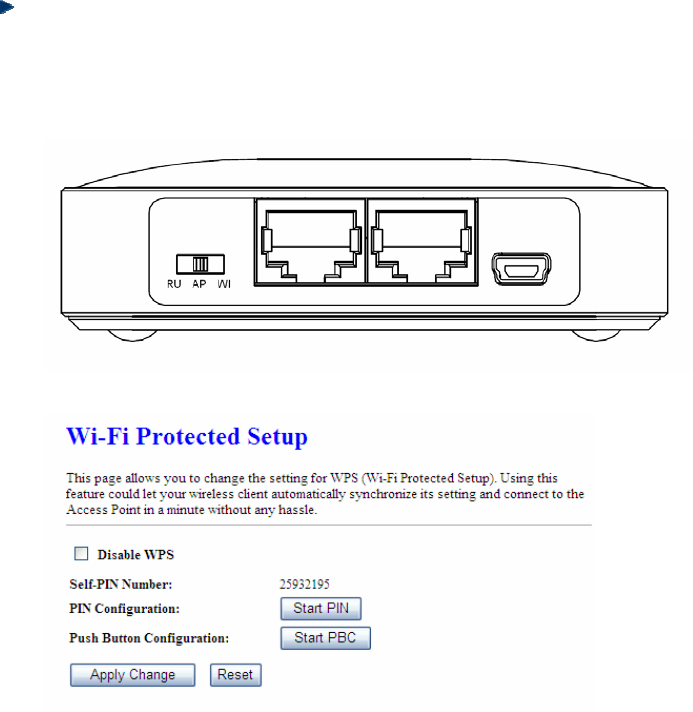
Version 1.0.15
139
7.2.6 WPS
Wi-Fi Protected Setup (WPS) is an easy way to establish a secured wireless network
between 11N Mini Broadband Router and wireless card. Users do not need to manually
entering a creative, yet predictable security key on both Wi-Fi devices to prevent unwanted
access to their wireless network. With WPS, it can automatically configure a wireless network
with a network name (SSID) and strong WPA data encryption and authentication.
WPS can be enabled by 2 methods:
1. PBC (Push button configuration) Method, in which the user simply has to push a
button, either an actual or a virtual one, on both WPS devices to connect.
2. PIN (Personal Identification Number) Method, in which a PIN has to be taken either
from a sticker label or from the web interface of the WPS device. This PIN will then be
entered in the AP or client WPS device to connect.
Please follow instructions below to enable the WPS function.
Start PBC:
(1.) Press the WPS button from 11N Mini Broadband Router or click Start PBC from
menu “Wi-Fi Protected Setup”, and waiting for the WPS wireless card setting.
or
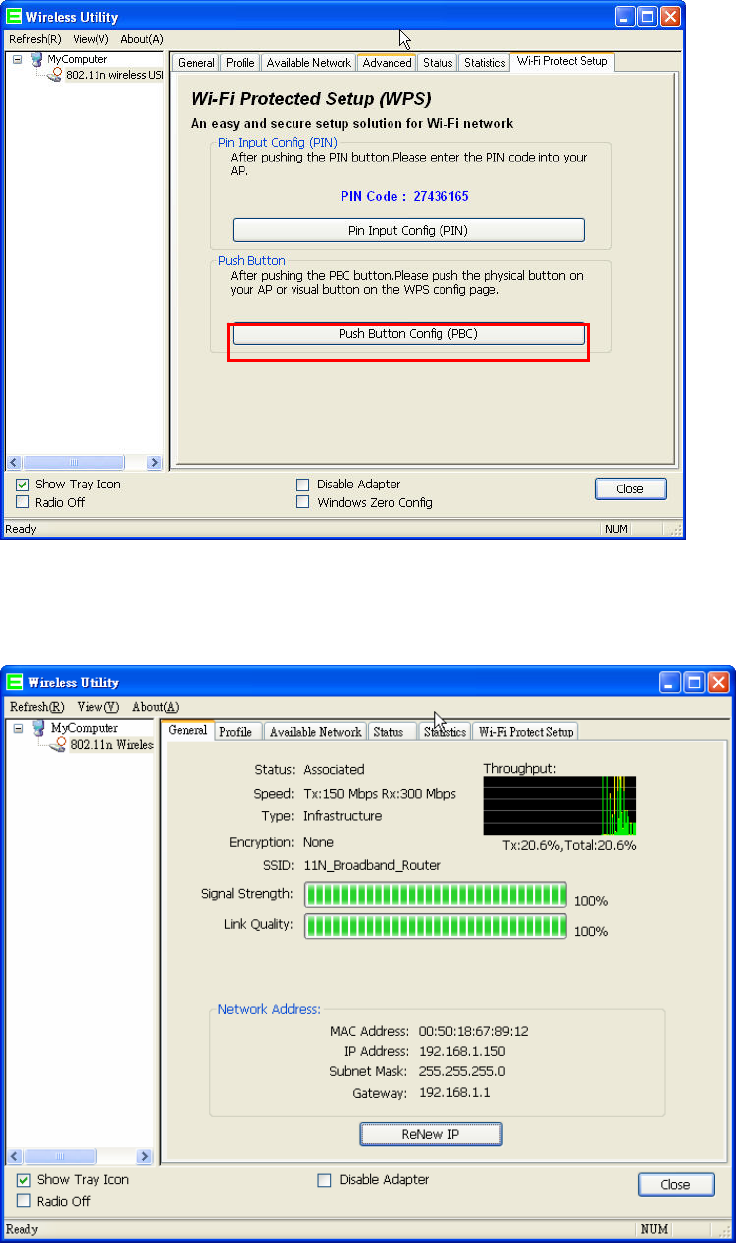
Version 1.0.15
140
(2.) Open the “Wireless Utility” of your wireless card, and click its “PBC” button, to
start auto pairing.
(3.) While scanning is successful, the information of the wireless card appears in the
windows below.
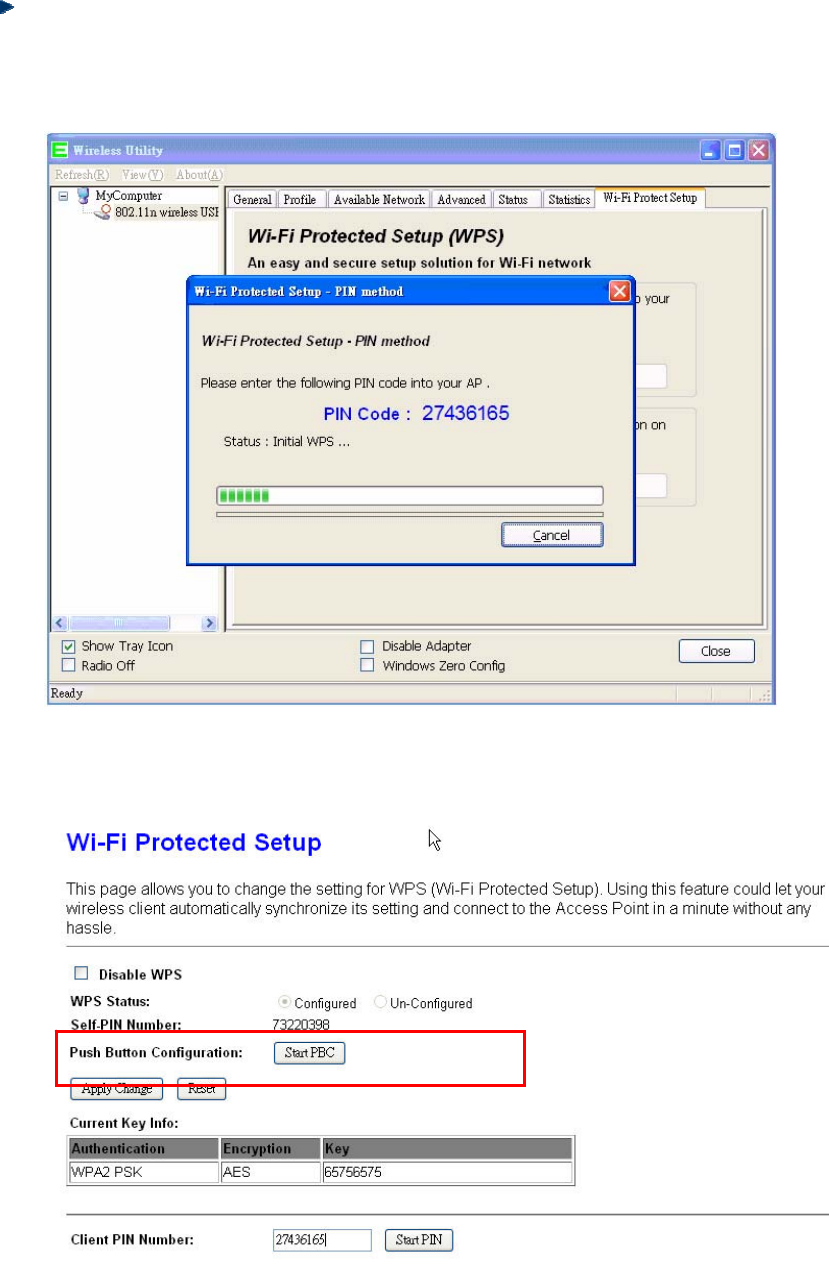
Version 1.0.15
141
Start PIN:
(1.) Open the “Wireless Utility” of your wireless card. Follow its PIN instruction to get a
new PIN number. Write it down.
(2.) Open menu “Wi-Fi Protected Setup” of 11N Mini Broadband Router , input the
PIN number from the wireless card then click Start PIN.
(3.) Back to “Wireless Utility” and press the “Start PIN” button to complete the
auto-paring process.
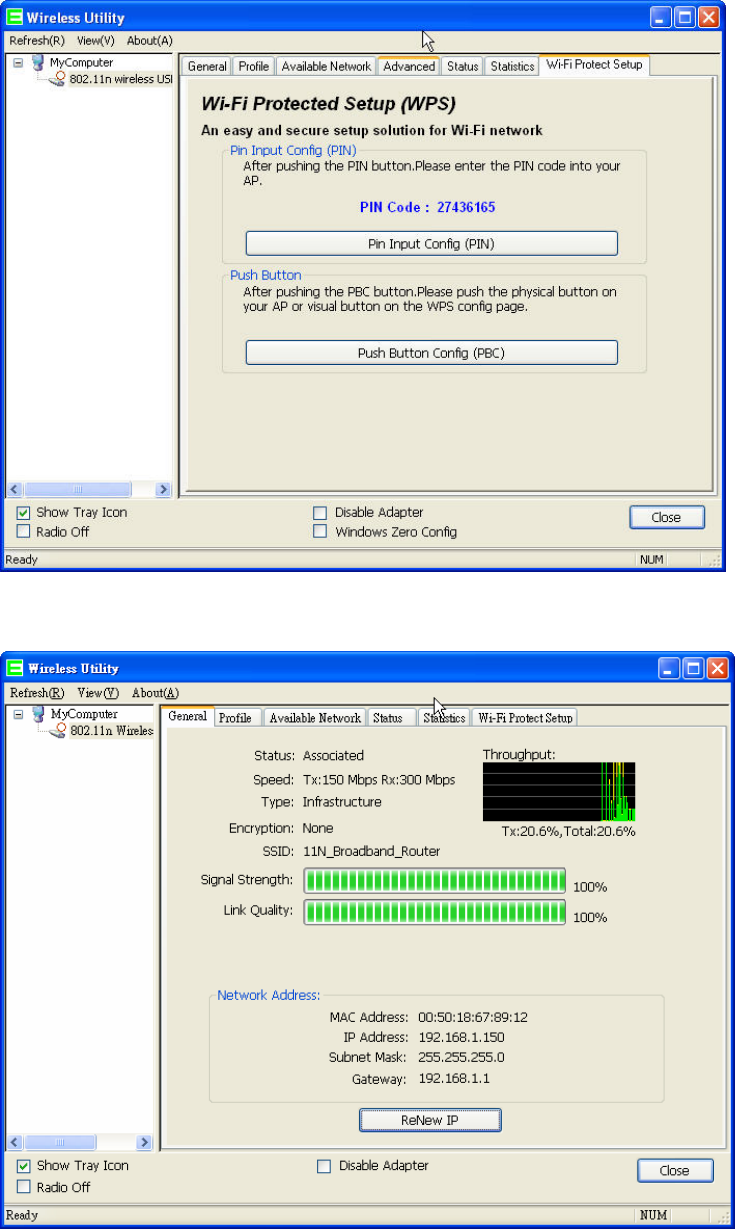
Version 1.0.15
142
(4.) When you can see the IP information below, the connection is established
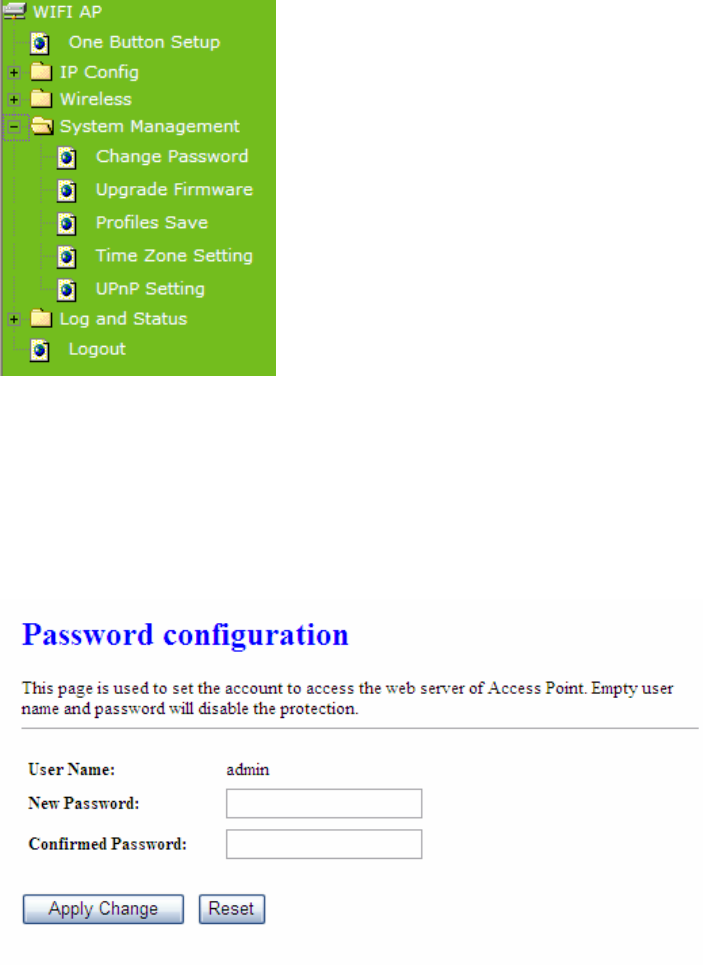
Version 1.0.15
143
7.3 System Management
11N Mini Broadband Router provides system management including password changing,
firmware upgrade, time setting, user’s account setting and other detail settings. Following is
detail explanation for each.
7.3.1 Change Password
Users can set or change their password in this section.
1. New Password
Enter the new password you want to change.
2. New Password (Confirm)
Enter the new password again for confirming.
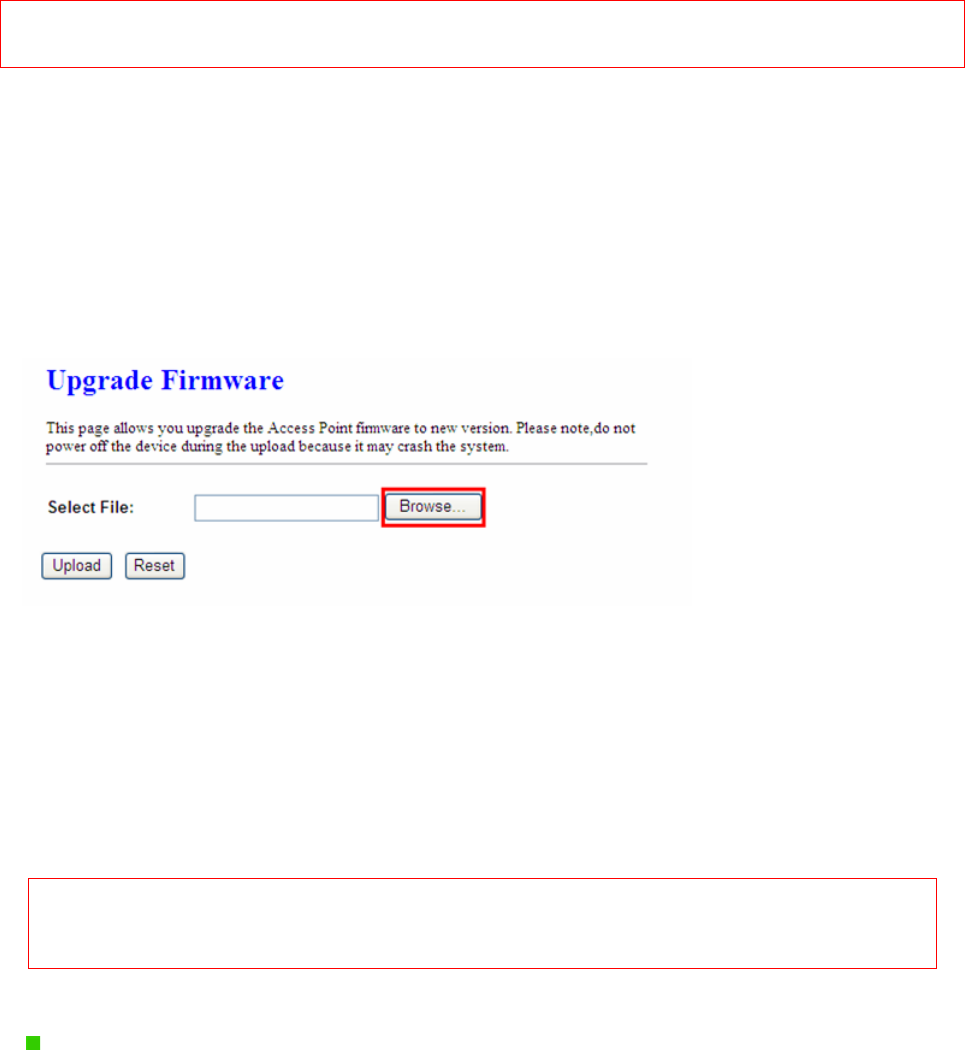
Version 1.0.15
144
3. Apply Change & Reset
Click on Apply Changes to save the setting data. Or you may click on Reset to clear all the
input data.
Note: 1. Only the password can be changed, the user name for administrator is admin and not to be changed.
2. If you forget administrator’s password, please reset 11N WLAN Mobile Server Router to default setting by
pressing the “Reset” button on the rear panel over 10 seconds. And the password will return to admin.
7.3.2 Upgrade Firmware
There is certain risk while upgrading firmware. Upgrading firmware is not recommended
unless the significant faulty is found. You can upgrade the firmware of 11N Mini Broadband
Router on this page. Make sure the firmware you want to use is on the local hard drive of
the computer. Click Upgrade Firmware to proceed.
1. Update Firmware
Click on Browse… button to search your local hard drive and locate the firmware to be
used for update.
2. Upload & Reset:
Click Upload to upgrade the firmware or Reset to restore to factory default Settings
Note: 1. To prevent the firmware upgrading interrupted by other wireless signals and caused failure. We
recommend using wired connection to do the upgrading.
2. Before upgrading the firmware, please remove any USB device which connected with this router.
3. The firmware upgrade will not remove your previous settings.
Reset button:
On the back of this router, there is a reset button. If you can not login the administrator page
by forgetting your password; or the router has problem you can’t solve. You can push the
reset button for 10 seconds with a stick. The router will reboot and all settings will be restored
to factory default settings. If the problem still exists, you can visit our web site to see if there is
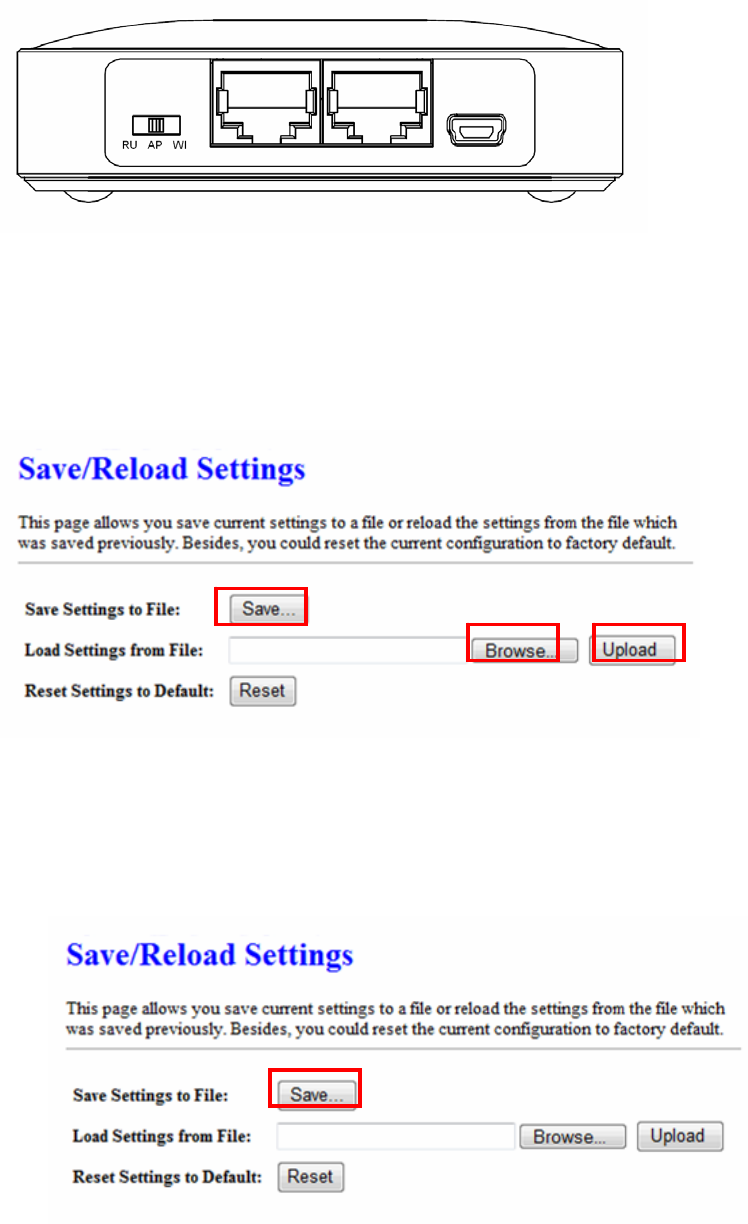
Version 1.0.15
145
any firmware for download to solve the problem.
7.3.3 Save / Reload Settings
To back up the current configuration setting or load the backup data, also you can restore 11N
Mini Broadband Router to default setting by this function.
1. Save Settings To File
Step 1. Click on Save button for saving the configuration setting into assigned
location.
A pop window will show up and ask to save config.dat file.
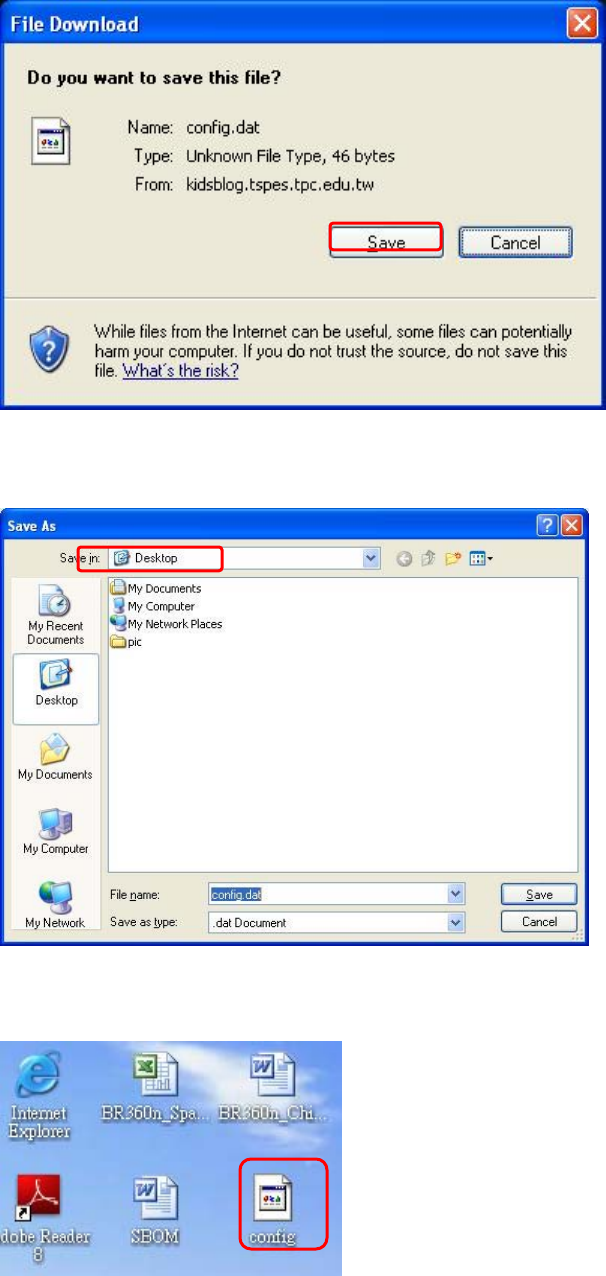
Version 1.0.15
146
Step 2. Please select the location, for example: the desktop.
Step 3. The file you just saved will appear on the desktop.
2. Load Settings From File
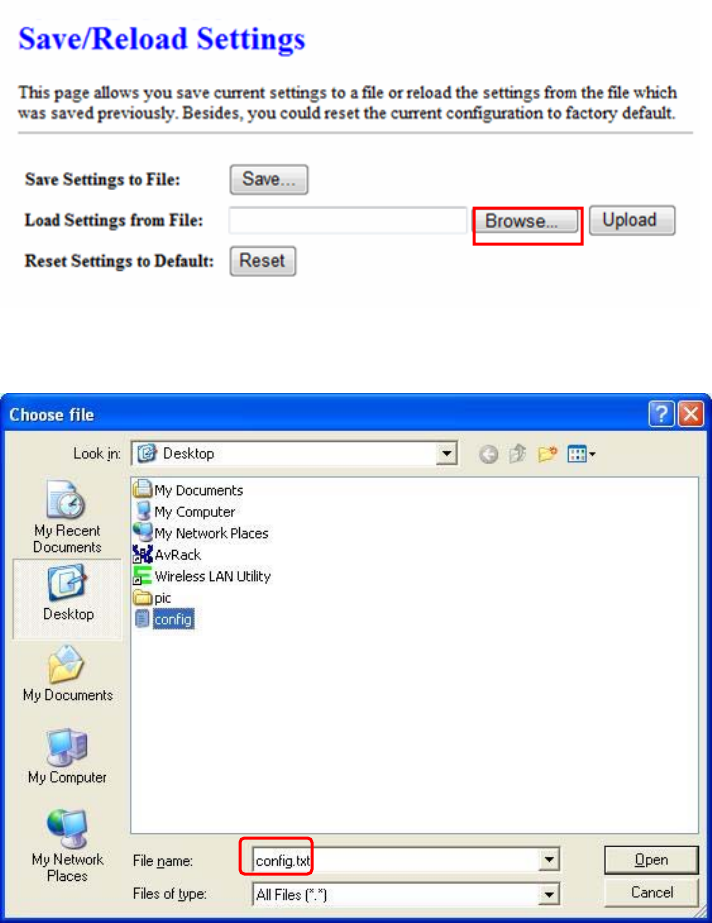
Version 1.0.15
147
Step 1. Click on “Browse…” button for searching the saving configuration from hard
drive, and then click on Upload button to load all the settings into the router.
Step 2. Select the config.dat file.
Step 3. Click Upload to retrieve.
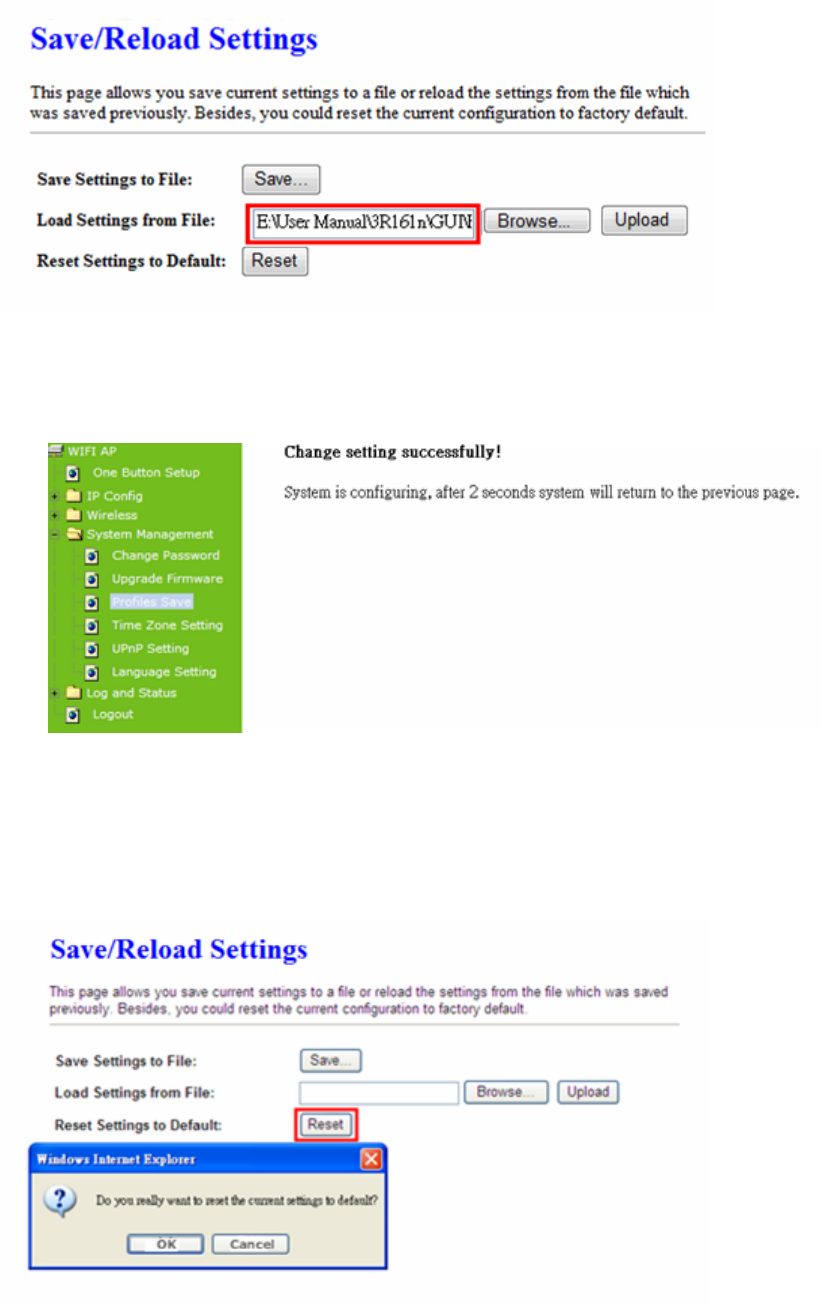
Version 1.0.15
148
Step 4. When you see the screen below, the updating is completed. Please click OK
to return to the main menu.
3. Reset Setting to Default
After you have tried other methods for troubleshooting your network, you may choose to
restore 11N Mini Broadband Router to the factory default settings.
When you see the screen below, the resetting is completed. Please click OK and return to the
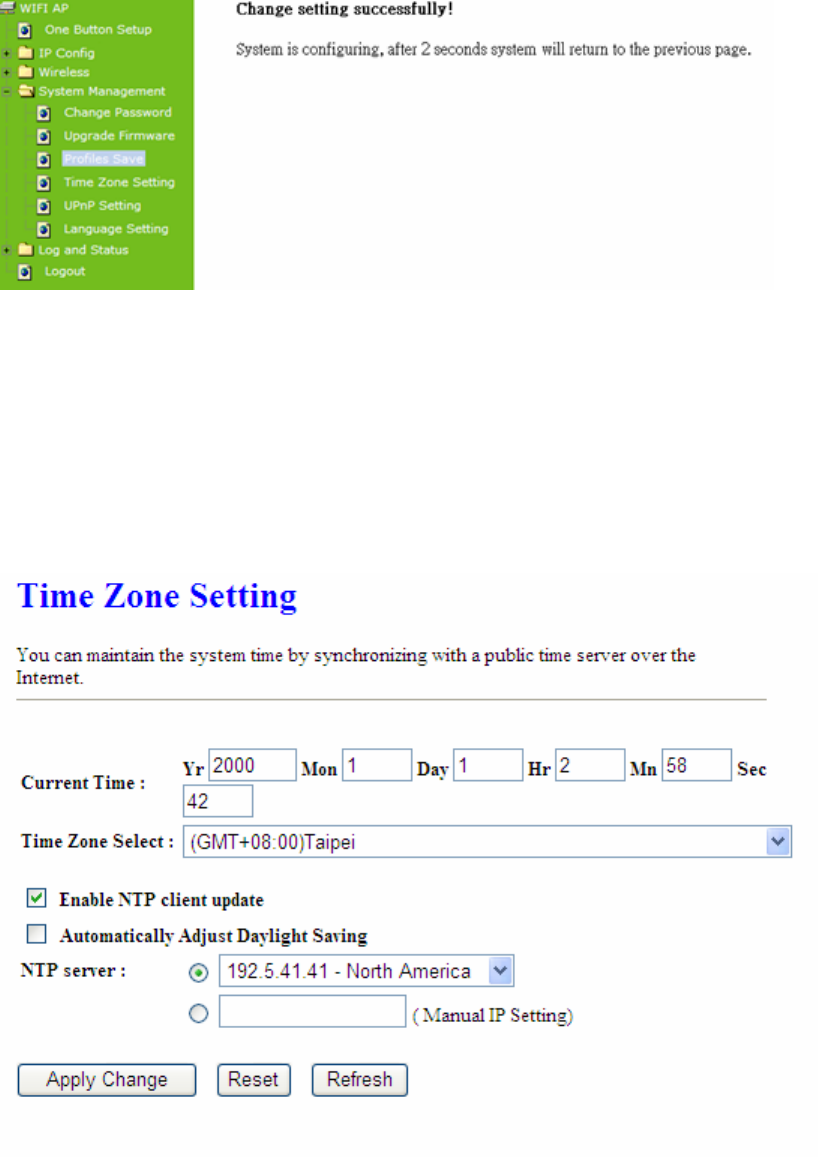
Version 1.0.15
149
main menu.
7.3.4 Time Zone Setting
The System time is the time used by 11N Mini Broadband Router for scheduling services.
You can manually set the time or connect to a NTP (Network Time Protocol) server. If a NTP
server is set, you will only need to set the time zone. If you manually set the time, you may
also set Daylight Saving dates and the system time will automatically adjust on those dates.
1. Current Time
Users can input the time manually.
Version 1.0.15
150
2. Time Zone Select
Select your time zone location from the drop-down list.
3. Enable NTP client update
Check to enable NTP client update.
4. Automatically Adjust Daylight Saving
If you are in daylight saving time area, please enable this item.
5. NTP server
Please select the NTP server from the pull-down list, or you can enter the NTP server IP
address manually.
6. Apply Changes & Reset & Refresh
Please click on Apply Changes to save the setting data. Or you may click on Reset to clear
all the input data. Or you may click on Refresh to update the system time on the screen.
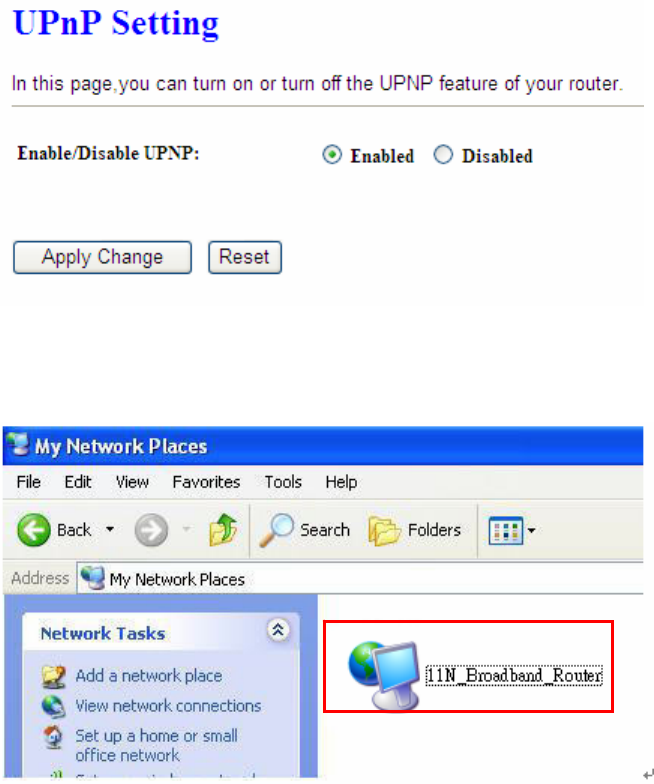
Version 1.0.15
151
7.3.5 UPnP Setting
UPnP (Univsersal Plug and Play) allows users to connect their UPnP-enabled Mini Router,
printer server and other devices right to the network with zero-configuration, meaning easier
setup for installing the device on the network. The automatic discovery feature enables the
device to obtain an IP address, present and describe itself to other devices and PCs on the
network without having to install drivers, but to configure and use those devices.
After enabling UPNP, click My Network Places, and user can open the web GUI by just
clicking on the Internet Gateway Device icon.
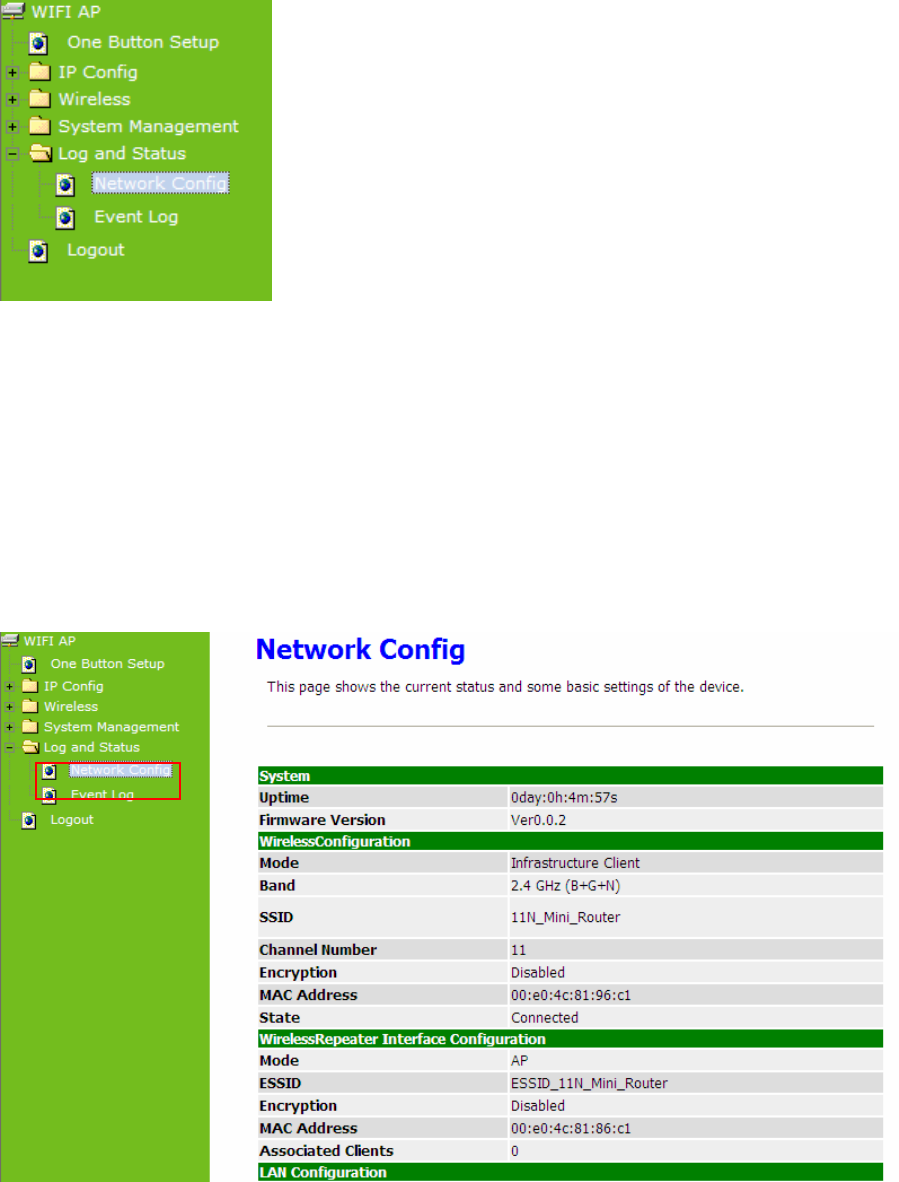
Version 1.0.15
152
7.4 Log & Status
11N Mini Broadband Router provides the log list and connection status for user to check.
7.4.1 Network Config
Network Configuration shows the firmware version and the connection status of LAN, WAN
and Wireless.
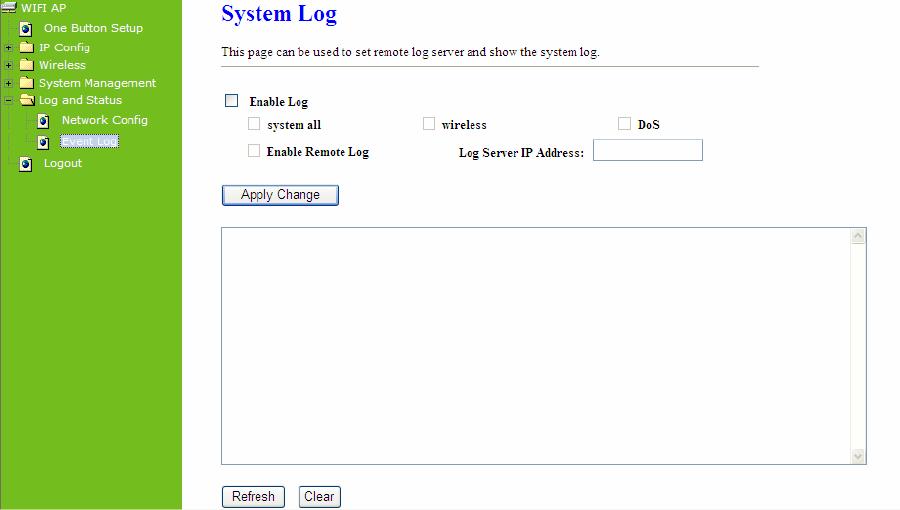
Version 1.0.15
153
7.4.2 Event Log
11N Mini Broadband Router provides system logs for review.
1. Enable Log
Select Enable Log to record the system log
2. system all, wireless & DoS
Select Wireless, DoS or system all to record
3. Enable Remote Log
You may choose to enable the remote event log or not.
4. Log Server IP Address
Please input the log server IP Address.
5. Apply Changes & Refresh & Clear
Click on Apply Changes to save the setting data. Click on Refresh to renew the system time,
or on Clear to clear all the record.
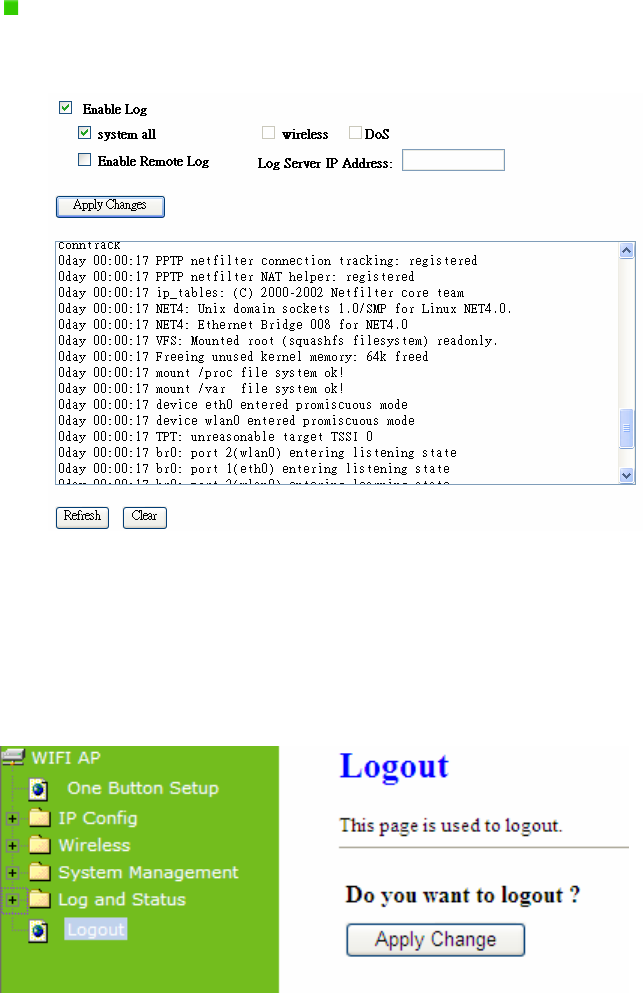
Version 1.0.15
154
After clicking Apply Changes to record the event log, it will be shown as the example
below.
7.5 Logout
Click Logout on the bottom menu to exit and go back to GUI login home page.
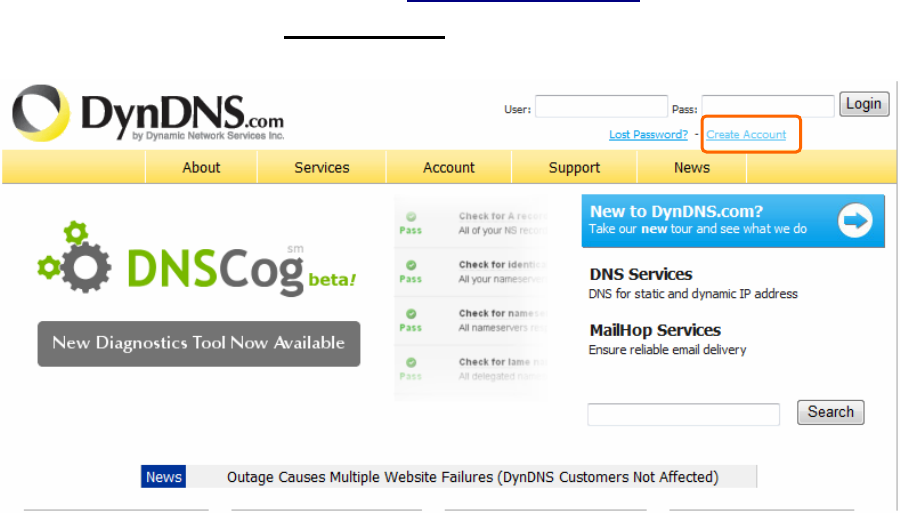
Version 1.0.15
155
Chapter 8 DDNS Service Application
DDNS is a service changes the dynamic IP to the static IP. The settings of DDNS can solve
the problem of being given the different IP by router every time. After setting the Router, your
host name would correspond to your dynamic IP. Moreover, via the host name application, it
could be easier for you to use FTP, Webcam and Printer remotely.
Dynamic DNS allows you to make an assumed name as a dynamic IP address to a static
host name. Please configure the dynamic DNS below. Please select Dynamic DNS under
the IP Config folder, and follow the instructions below to enter the Dynamic DNS page to
configure the settings you want.
If you don’t have a DDNS account, please follow the steps to complete your DDNS with
Dynamic IP settings.
Step 1. First access the Internet and fill http://www.dyndns.com/ into the address field of
your web browser, then click Create Account.
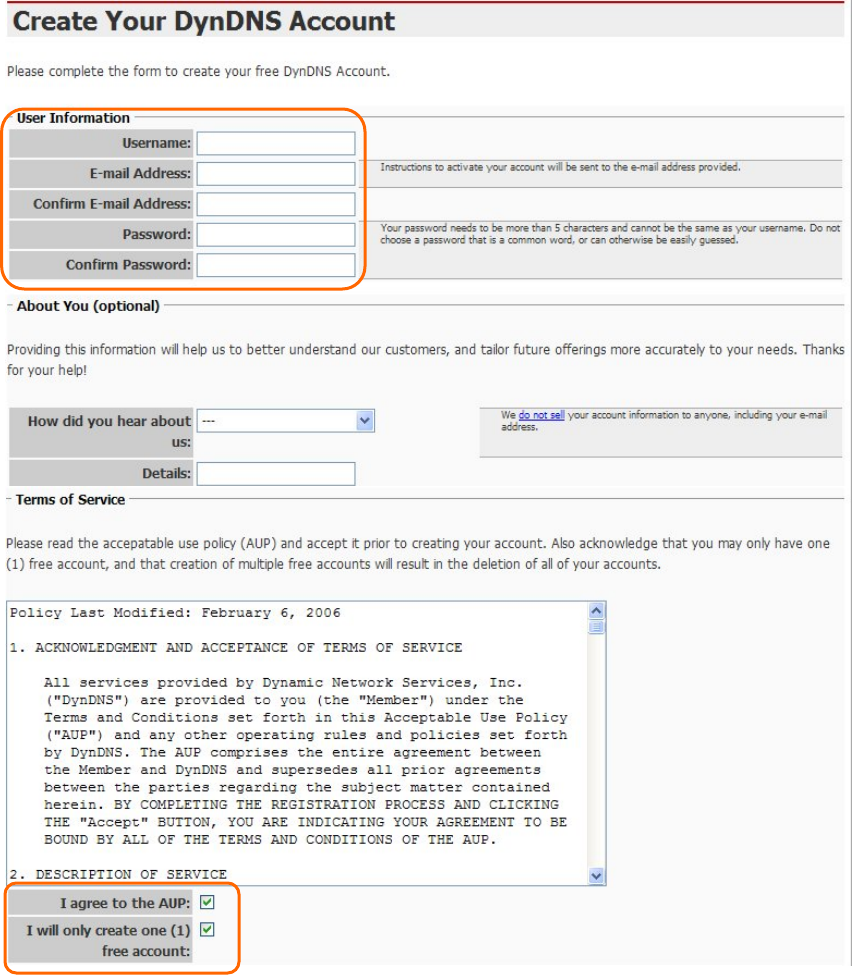
Version 1.0.15
156
Step 2. Fill in the form as required, and then click on Create Account button.
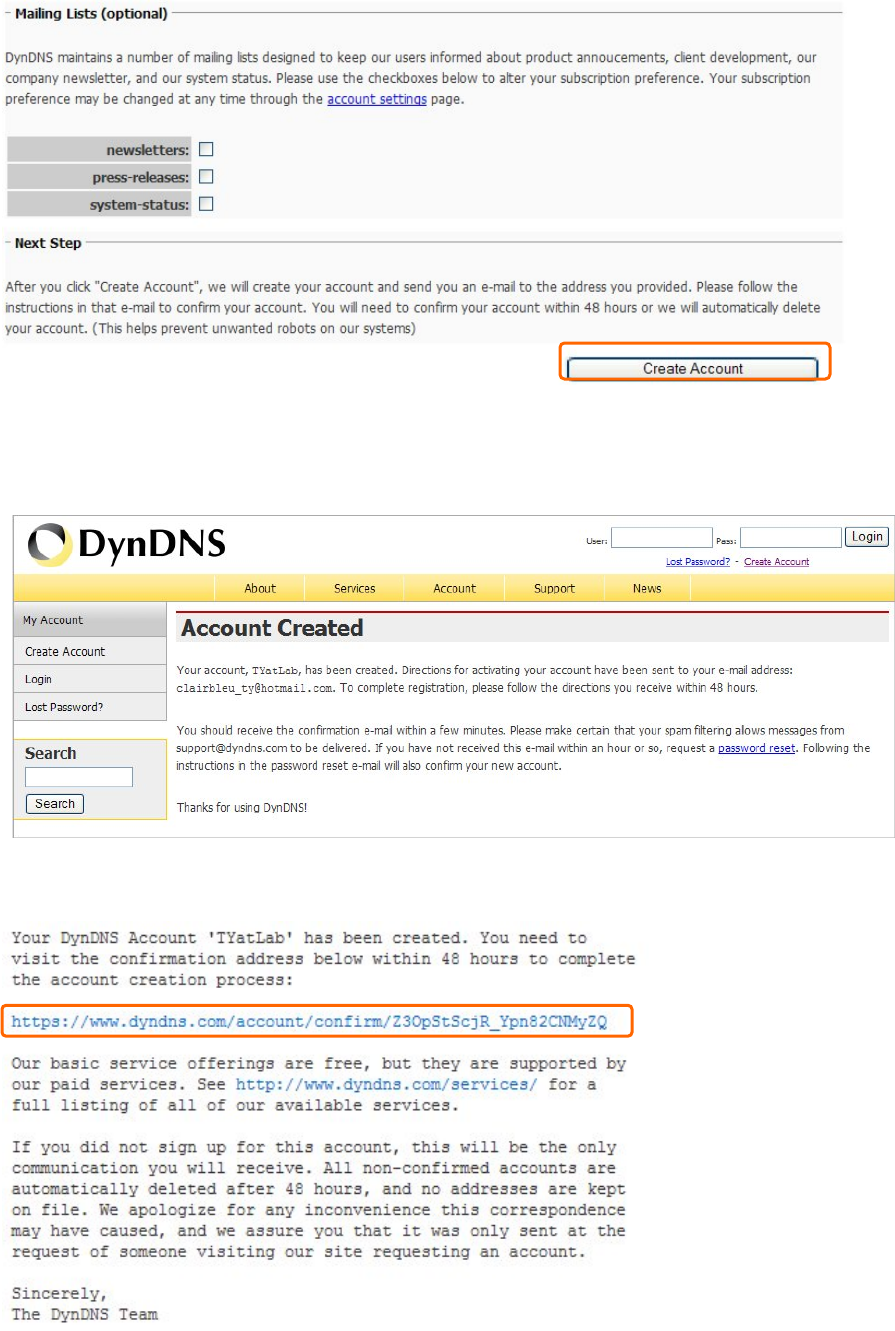
Version 1.0.15
157
Step 3. When you got this account created message, close it, and check your mailbox. You
would get a mail from DynDNS website.
Step 4. Click on the indicated address within your mail to confirm.
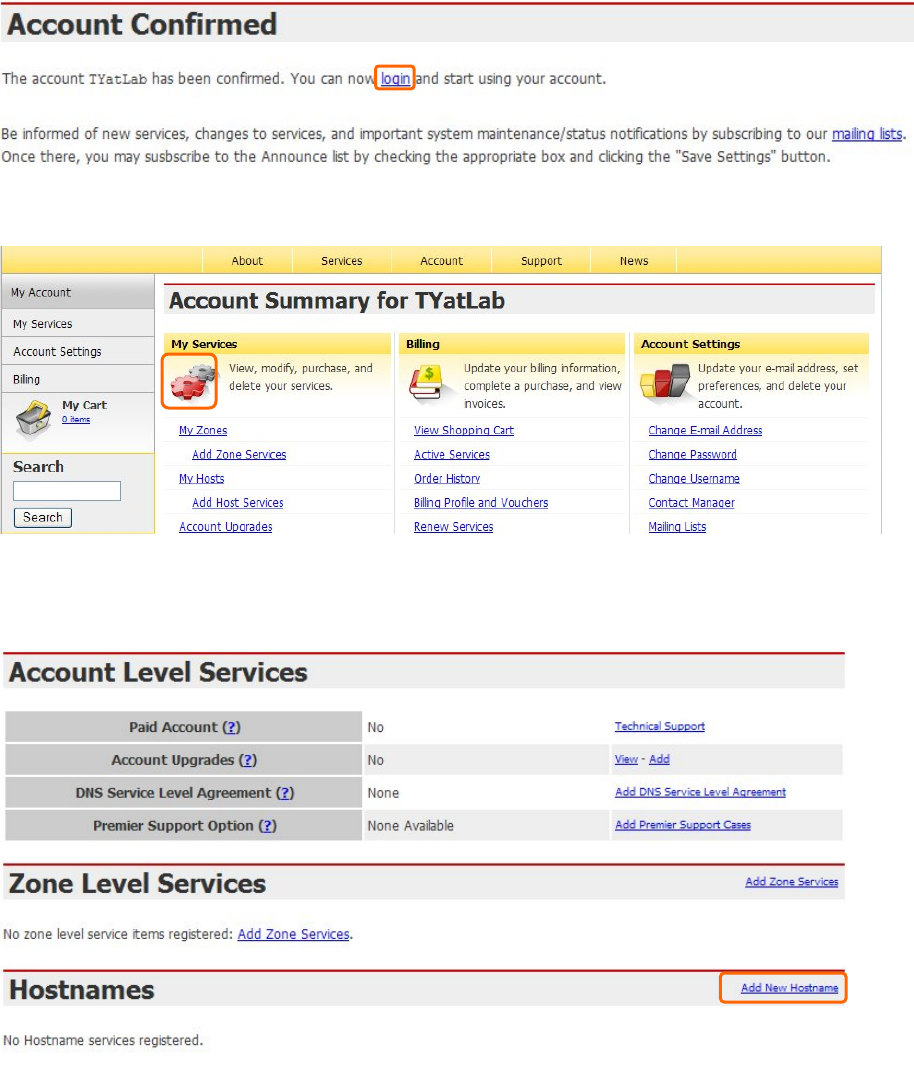
Version 1.0.15
158
Step 5. Click on login.
Step 6. Click My Services after logging in.
Step 7. Click Add New Hostname.
Step 8. Put in your favorite hostname and service type, and then click Create Host after
finished.
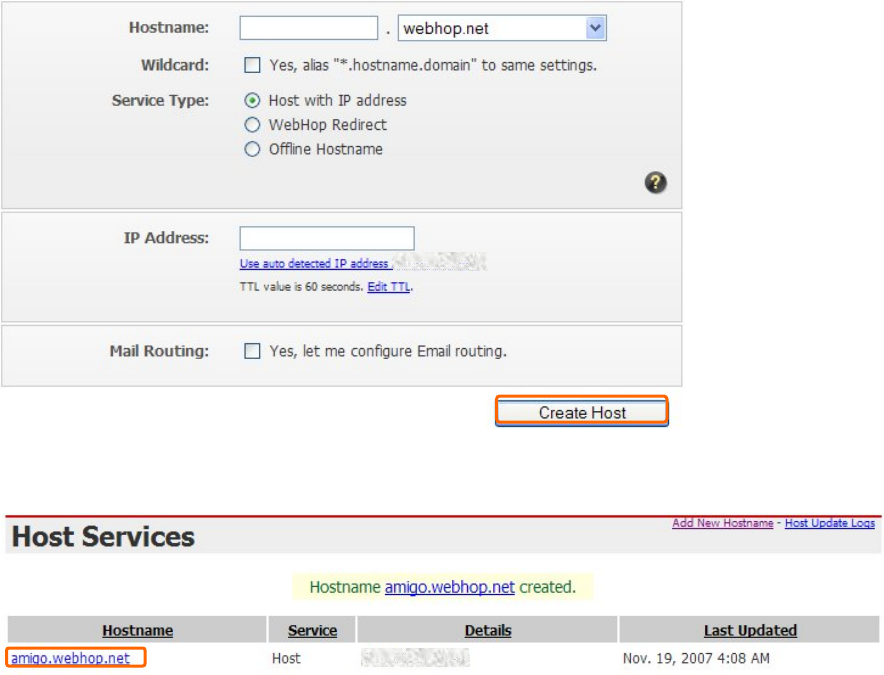
Version 1.0.15
159
Step 9. Your hostname has been created when you see the following page.
Version 1.0.15
160
Chapter 9 Q & A
9.1 Installation
1. Q: Where is the XDSL Router installed on the network?
A: In a typical environment, the Router is installed between the XDSL line and the LAN.
Plug the XDSL Router into the XDSL line on the wall and Ethernet port on the Hub
(switch or computer).
2. Q: Why does the throughput seem slow?
A: To achieve maximum throughput, verify that your cable doesn’t exceed 100 meter. If
you have to do so, we advise you to purchase a bridge to place it in the middle of the
route in order to keep the quality of transmitting signal. Out of this condition you
would better test something else.
z Verify network traffic does not exceed 37% of bandwidth.
z Check to see that the network does not exceed 10 broadcast messages per
second.
z Verify network topology and configuration.
9.2 LED
1. Why doesn’t 11N Mini Broadband Router power up?
A: Check if the output voltage is suitable, or check if the power supply is out of order.
2. The Internet browser still cannot find or connect to 11N Mini Broadband Router
after verifying the IP address and LAN cable, the changes cannot be made, or
password is lost.
A: In case 11N Mini Broadband Router is inaccessible; you can try to restore its
factory default settings. Please press the “Reset” button and keep it pressed for over
7 seconds and the light of STATUS will vanish. The LEDs will flash again when reset
is successful.
3. Why does 11N Mini Broadband Router shut down unexpectedly?
A: Re-plug your power adapter. Then, check the STATUS indicator; if it is off, the
internal flash memory is damaged. For more help, please contact with your provider.
Version 1.0.15
161
9.3 IP Address
1. Q: What is the default IP address of the router for LAN port?
A: The default IP address is 192.168.1.1 with subnet mask 255.255.255.0
2. Q: I don't know my WAN IP.
A: There are two ways to know.
Way 1: Check with your Internet Service Provider.
Way 2: Check the setting screen of 11N Mini Broadband Router . Click on Status
& Log item to select Network Configuration on the Main Menu. WAN IP
is shown on the WAN interface.
3. How can I check whether I have static WAN IP Address?
A: Consult your ISP to confirm the information, or check Network Configuration in 11N
Mini Broadband Router ’s Main Menu.
4. Will the Router allow me to use my own public IPs and Domain, or do I have to use
the IPs provided by the Router?
A: Yes, the Router mode allows for customization of your public IPs and Domain.
9.4 OS Setting
1. Why can’t my computer work online after connecting to 11N Mini Broadband
Router ?
A: It’s possible that your Internet protocol (TCP/IP) was set to use the following IP
address. Please do as the following steps. (Windows 2000 & XP) Start>Settings>
Network and Dial-up Connections>double click on Internet Protocol(TCP/IP)>
select obtain IP address automatically> Click on OK button. Then, open Internet
browser for testing. If you still can’t go online, please test something else below.
z Verify network configuration by ensuring that there are no duplicate IP
addresses.
z Power down the device in question and ping the assigned IP address of the
device. Ensure no other device responds to that address.
z Check that the cables and connectors or use another LAN cable.
Version 1.0.15
162
2. Q: Why can't I connect to the router's configuration utility?
A: Possible Solution 1: Make sure that your Ethernet connect properly and securely.
Make sure that you've plugged in the power cord.
Possible Solution 2: Make sure that your PC is using an IP address within the range
of 192.168.1.2 to 192.168.1.254. Make sure that the address of the subnet mask is
255.255.255.0. If necessary, the Default Gateway data should be at 192.168.1.1. To
verify these settings, perform the following steps:
Windows 95, 98, or My Users:
1. Click on Windows Start > click on Run > input winipcfg > click on OK button.
2. Check the IP Address, Subnet Mask, Default Gateway data. Is this data
correct? If the data isn't correct, click on Release All. Then click on Renew All.
Windows NT, 2000, or XP Users:
1. Click on Windows Start > click on Run > input cmd > click on OK button.
2. At the DOS prompt, type ipconfig/all.
3. Check the IP Address, Subnet Mask, Default Gateway data. Is this data
correct? If the data isn't correct. Please input ipconfig/release > press Enter >
input ipconfig/renew > press Enter.
Possible Solution 3: Verify the connection setting of your Web browser and verify
that the HTTP Proxy feature of your Web browser is disabled. Make these
verifications so that your Web browser can read configuration pages inside your
router. Launch your Web browser. Internet Explorer Users:
1. Click on Tools > Internet Options > Connections tab.
2. Select never dial a connection, click on Apply button, and then click on OK
button.
3. Click on Tools and then click on Internet Options.
4. Click on Connections and then click on LAN Settings.
5. Make sure none of the check boxes are selected and click on OK button.
6. Click on OK button.
Netscape Navigator Users:
1. Click on Edit > Preferences > double-click Advanced in the Category window.
2. Click on Proxies > select Direct connection to the Internet > click on OK button.
3. Click on Edit again and then click on Preferences.
Version 1.0.15
163
4. Under category, double-click on Advanced and then click on Proxies.
5. Select Direct connection to the Internet and click on OK button.
6. Click on OK button.
3. Q: Web page hangs, corrupt downloads, or nothing but junk characters is being
displayed on the screen. What do I need to do?
A: Force your NIC to 10Mbps or half duplex mode, and turn off the "Auto-negotiate"
feature of your NIC as a temporary measure. (Please look at the Network Control
Panel, in your Ethernet Adapter's Advanced Properties tab.)
4. Q: Why can't I connect to the Web Configuration?
A: you can remove the proxy server settings in your web browser.
9.5 11N Mini Broadband Router Setup
1. Q: Why does 11N Mini Broadband Router ’s setup page shut down unexpectedly?
A: If one of the pages appears incompletely in 11N Mini Broadband Router ’s setup
pages, please click on Logout item on the Main Menu before shutting it down. Don’t
keep it working. Then, close Internet browser and open it again for going back to the
previous page.
2. Q: Why can’t my USB devices and LAN ports work properly after setting the
DHCP?
A: There are two rules over here.
Rule1: After connecting USB devices, please reboot your Router.
Rule2: Before finishing the DHCP setup, please don’t connect any computer to LAN
ports, because the conflict of having the same IP may occur and cause some
computers a lot of trouble.
※
Notice: Make sure that you always click on the Apply button after configuring
each setting. And in order to let other LAN ports work properly, please reboot
your PC.
3. Q: I don’t know how to configure DHCP.
A: DHCP is commonly used in the large local network. It allows you to manage and
distribute IP addresses from 2 to 254 throughout your local network via 11N Mini
Broadband Router . Without DHCP, you would have to configure each computer
Version 1.0.15
164
separately. It’s very troublesome. Please Open Internet browser > Input
192.168.1.1 in the website blank field > Select DHCP Server under the IP Config
Menu. For more information, please refer to 3.3.2 (Router Mode) or 4.3.1 (AP Mode).
4. Q: How do I upgrade the firmware of 11N Mini Broadband Router ?
A: Periodically, a new Flash Code is available for 11N Mini Broadband Router on your
product supplier’s website. Ideally, you should update 11N Mini Broadband Router ’s
Flash Code using Firmware Upgrade on the System Management menu of 11N
Mini Broadband Router Settings.
5. Q: My 11n Mobile Server Router cannot connect to the ISP?
A: There are three possible solutions.
1. Check the Cable/XDSL modem is power on.
2. Check the Cable/XDSL link light is on to verify a good physical connection.
3. Check the WAN port LED to verify if the Cable/XDSL modem is connected to the
router:
If your ISP Login method is following, please make sure the username and password
are correct or not.
If your ISP is using dynamic IP addressing (DHCP) then the DHCP protocol does not
have the authentication feature. Some Cable service providers often use the following
to determine user’s identification.
6. Q: Why is that I can ping to outside hosts, but cannot access Internet websites?
A: Check the DNS server settings on your PC. You should get the DNS servers settings
from your ISP. If your PC is running a DHCP client, remove any DNS IP address
setting. As the router assign the DNS settings to the DHCP-client-enabled PC.
7. Q: 11N Mini Broadband Router couldn’t save the setting after click on Apply
button?
A: 11N Mini Broadband Router will start to run after the setting finished applying, but
the setting isn’t written into memory. Here we suggest if you want to make sure the
setting would be written into memory, please reboot the device via Reboot under
System Management directory.
Version 1.0.15
165
9.6 Wireless LAN
1. Q: Why couldn’t my wireless notebook work on-line after checking?
A: Generally, Wireless networks can sometimes be very complicated to set up,
particularly if you're dealing with encryption and products from different vendors. Any
number of variables can keep your workstations from talking to each other. Let's go
over some of more common ones.
For starters, verify that your router and your workstation are using the same SSID
descriptions. SSID acts as a password when a mobile device tries to connect to the
wireless network. The SSID also differentiates one WLAN from another, so all
access points and all devices attempting to connect to a specific WLAN must use the
same SSID. A workstation will not be permitted to connect to the network unless it
can provide this unique identifier. This is similar to the function of your network's
Workgroup or Domain name.
When you're experiencing conductivity problems, it is always best to keep things
simple. So next you are going to do is that, please disable any WEP encryption you
might have configured.
Successful implementation of encryption also includes the use of a shared key. A
HEX key is the most common, but other formats are also used. This key identifies
the workstation to the router as a trusted member of this network. Different
manufacturers can implement this key technology in ways that might prevent them
from working correctly with another vendor's products. So pay attention to detail is
going to be the key to a successful installation.
Next make sure the router and the NIC are configured to use the same
communications channel. There are normally 11 of them, and the default channel
can also vary from vendor to vendor. You might also want to confirm that the router
has DHCP services enabled and an address pool configured. If not, the NIC won't be
able to pick up an IP address. I have run across a few access points that offer DHCP
services but do not assign all of the needed IP information to the NIC. As a result, I
was able to connect to the network, but could not browse the web. The point is, don't
assume anything. Verify for yourself that all of the required settings are being
received by the workstation.
Finally, you might want to keep the system you're trying to configure in the same
room as the router, at least during the initial configuration, in order to minimize
potential interference from concrete walls or steel beams.
Version 1.0.15
166
2. Q: My PC can’t locate the Wireless Access Point.
A: Check the following:
z Your PC is set to Infrastructure Mode. (Access Points are always in Infrastructure
Mode.)
z The SSID on your PC and the Wireless Access Point are the same. Remember
that the SSID is case-sensitive. So, for example “Workgroup” does NOT match
“workgroup”.
z Both your PC and the Wireless Access Point must have the same setting for
WEP. The default setting for the Wireless Router is disabled, so your wireless
station should also have WEP disabled.
z If WEP is enabled on the Wireless Router, your PC must have WEP enabled,
and the key must match.
z If the Wireless Router’s Wireless screen is set to Allow LAN access to selected
Wireless Stations only, then each of your Wireless stations must have been
selected, or access will be blocked.
z To see if radio interference is causing a problem, see if connection is possible
when close to the Wireless Access Point. Remember that the connection range
can be as little as 100 feet in poor environments.
3. Q: Wireless connection speed is very slow.
A: The wireless system will connect at highest possible speed, depending on the
distance and the environment. To obtain the highest possible connection speed, you
can experiment with following:
z Access Point location: Try adjusting the location and orientation of the Access
Point.
z Wireless Channel: If interference is the problem, changing to another channel
may show a marked improvement.
z Radio Interference: Other devices may be causing interference. You can
experiment by switching other devices off, and see if this helps. Any “noisy”
devices should be shielded or relocated.
z RF Shielding: Your environment may tend to block transmission between the
wireless stations. This will mean high access speed is only possible when close
to the Access Point.
4. Q: Some applications do not run properly when using the Wireless Router.
Version 1.0.15
167
A: The Wireless Router processes the data passing through it, so it is not transparent.
Use the Special Application feature to allow the use of Internet applications which do
not function correctly. If this does solve the problem, you can use the DMZ function.
This should work with almost every application, but:
z It is a security risk, since the firewall is disabled.
z Only one (1) PC can use this feature.
5. Q: I can’t connect to the Wireless Router to configure it.
A: Check the following:
z The Wireless Router is properly installed, LAN connections are OK, and it is
powered ON.
z Make sure that your PC and the Wireless Router are on the same network
segment.
z If your PC is set to “Obtain an IP Address automatically” (DHCP client), restart it.
z If your PC uses a Fixed (Static) IP address, make sure that it is using an IP
Address within the range 192.168.1.129 to 192.168.1.253 and thus compatible
with the Wireless Router’s default IP Address of 192.168.1.254. Also, the
Network Mask should be set to 255.255.255.0 to match the Wireless Router. In
Windows, you can check these settings by using Control Panel ~ Network to
check the Properties for the TCP/IP protocol.
6. Q: The WinXP wireless interface couldn’t communicate the WEP with 11N Mini
Broadband Router ’s wireless interface.
A: The default WEP of WinXP is Authentication Open System - WEP, but the WEP of
11N Mini Broadband Router is only for Shared Key - WEP, it caused both sides
couldn’t communicate. Please select the WEP of WinXP from Authentication Open
System to Pre-shared Key - WEP, and then the WEP wireless interface between
WinXP and 11N Mini Broadband Router would be communicated.
9.7 Support
1. Q: Why can’t the NTFS hard disk be used with 11N Mini Broadband Router ?
A: 11N Mini Broadband Router doesn’t support the NTFS hard disk. It only supports
EXT3 and FAT32 file systems.
2. Q: Why can’t my USB devices work on 11N Mini Broadband Router ?
Version 1.0.15
168
A: Maybe your USB devices and 11N Mini Broadband Router are not compatible. So if
you want to know whether your inserted device such as USB Web Camera, USB
Printer or USB HDD corresponds with 11N Mini Broadband Router , please check
with your product supplier.
3. Q: What is the maximum number of IP addresses that the XDSL Router will
support?
A: The Router will support to 253 IP addresses with NAT mode.
5. Q: Is the Router cross-platform compatible?
A: Any platform that supports Ethernet and TCP/IP is compatible with the Router.
9.8 Others
1. Q: Why can’t I receive corrupted FTP downloads?
A: If you are experiencing corrupted files when you download a file with your FTP client,
try using another FTP program.
2. Q: Why does the router dial out for PPPoE mode very often?
A: Normally some of game, music or anti-virus program will send out packets that
trigger the router to dial out, you can close these programs. Or you can set the idle
time to 0, then control to dial out manually.
3. Q: What can I do if there is already a DHCP server in LAN?
A: If there are two DHCP servers existing on the same network, it may cause conflict
and generate trouble. In this situation, we suggest to disable DHCP server in router
and configure your PC manually.
9.9 USB Device
1. Q: How many USB devices can be connected to the Product?
A: 11N Mini Broadband Router supports only 1 USB port and supports USB dongle.
Version 1.0.15
169
Chapter 10 Appendices
10.1 Operating Systems
1. Microsoft:Windows 2000, XP, Vista 32bit and the following related versions.
2. Apple:Mac OS X 10.4.7, Leopard and the following related versions.
3. Linux:Redhat 9, Fedora 6 & 7, Ubuntu 7.04 and the following related versions.
10.2 Browsers
1. Internet Explorer ver. 6 and 7 and the following related versions.
2. FireFox ver. 2.0.0.11 and the following related versions.3.
3. Safari ver. 3.04 and the following related versions.
10.3 Communications Regulation Information
Should any consumers need to learn more information, services and supports, please contact
the supplier of your product directly.